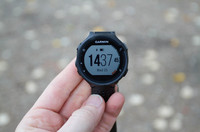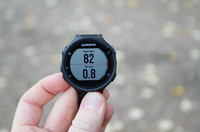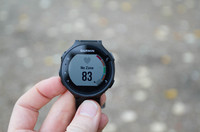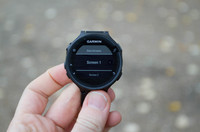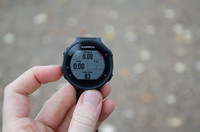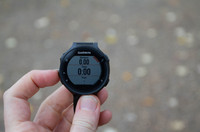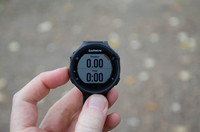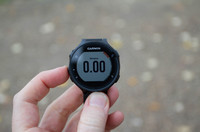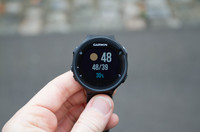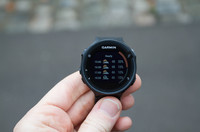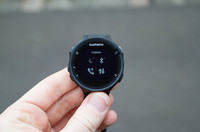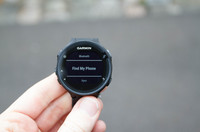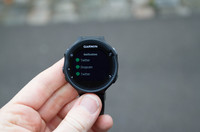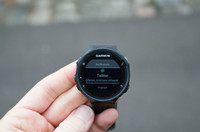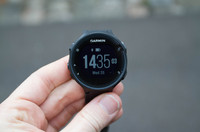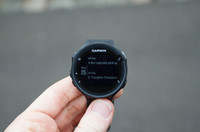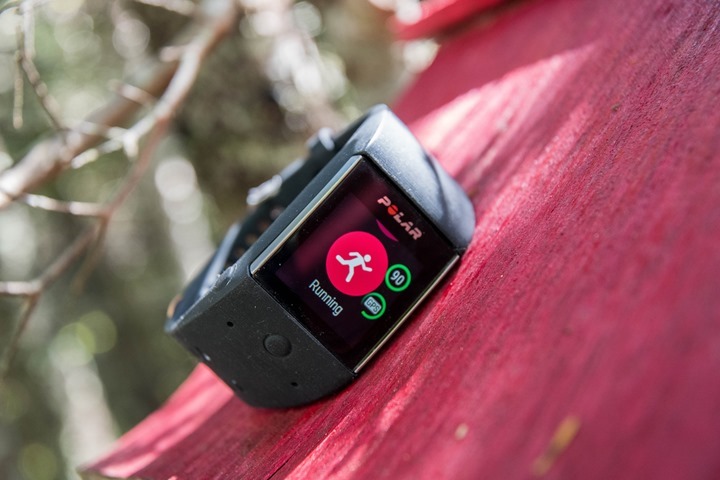Garmin Forerunner 230 235 In-Depth Review
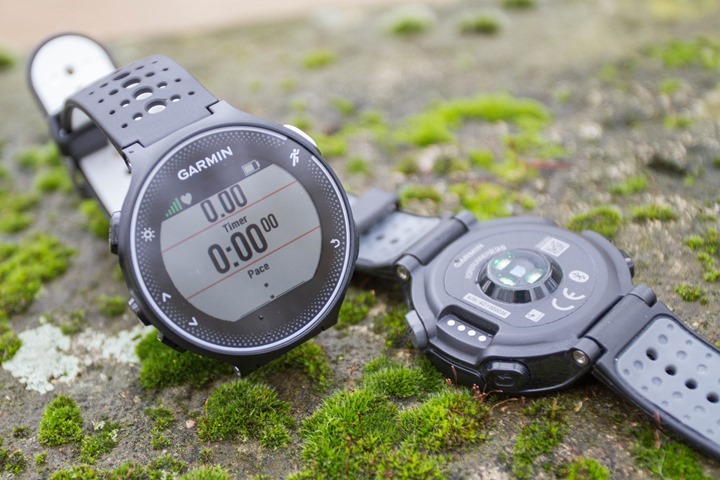
It’s been almost exactly a month since Garmin announced their lineup of fall running watches, including three new units: The Forerunner 230, 235, and 630. Each of those units replacing previous iterations of the FR220, 225, and 620. The FR230 and FR235 were unique though in that this time around they got pretty significant feature updates, bringing them far more in line with the FR620 of yesteryear, than other mid-range watches. Meanwhile, the FR235 also got a new optical sensor – this one developed fully in-house by Garmin.
This review will focus on the FR230 & FR235. While next week I’ll publish a review of the FR630. The only difference between the FR230 and FR235 is the optical sensor in the FR235 – that’s it. All other baseline features are the same.
For this review I was sent both a FR230 and FR235 to borrow from Garmin. Both are final production units, and this review is based on final production firmware (3.10+). After this review, I’ll be sending back all the demo units as usual to Garmin and getting my own – just the way I roll.
With that intro out of the way, let’s dive into things.
Unboxing:
Since this is a dual FR230 & FR235 product review, it would mean I have two boxes and thus two unboxing sections. However, in this case I’m temporarily going to provide you with a FR230 unboxing, and then follow-up with the official FR235 unboxing photos at a slightly later date (a week or so). The reason being simple: The FR230 arrived boxed, while the FR235 (final production unit) arrived naked in order to get it to me quicker. Don’t worry, it’s the same unit you have.
As for the differences between the two – well, one includes a HR strap (if on bundle) and one doesn’t…and the end. But let’s start at the beginning, with the box:
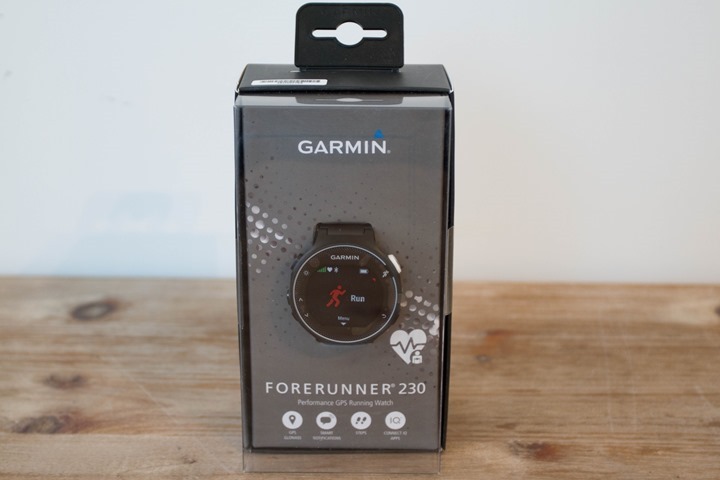
Once we crack it open we’ll find this small assortment of goodness worth of parts:
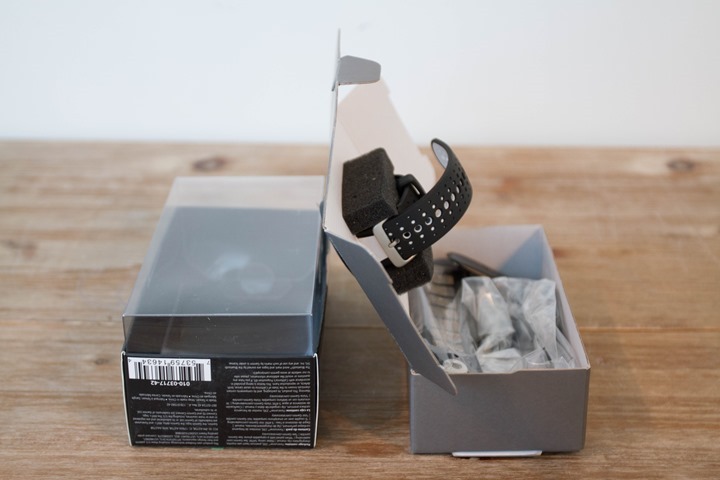
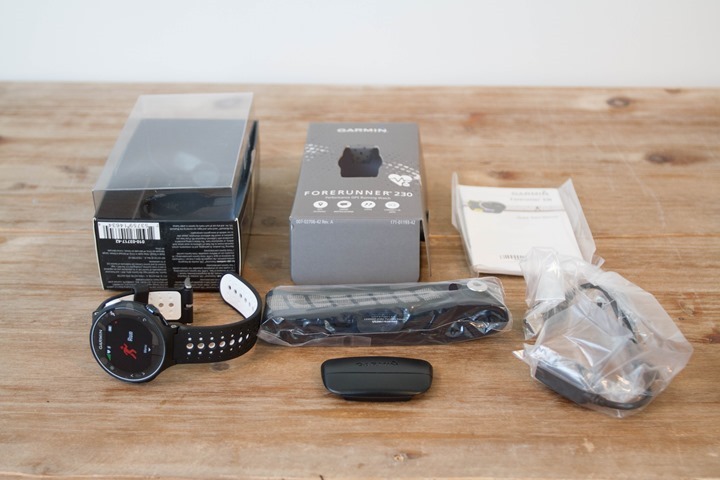
Removing the plastic, we get this:
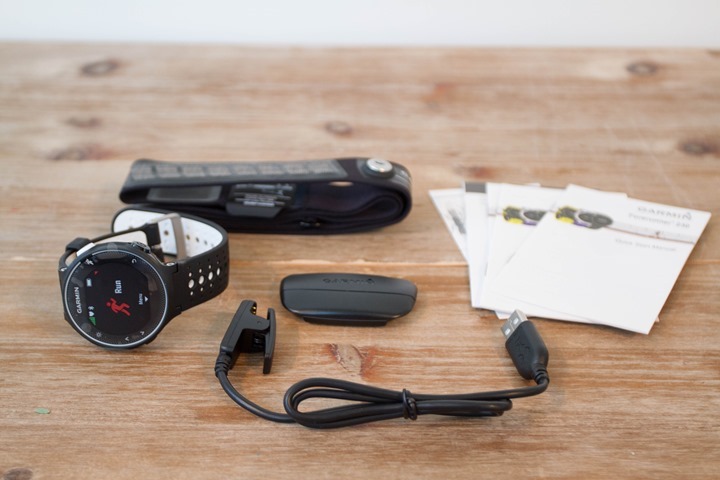
Ultimately, that comes down to four things: The FR230, the FR230 charger, the HRM4 heart rate strap, and some paper manual stuff.
The charging cable used on the FR230 is the same as on the FR235 and FR630. It is not compatible with any other Garmin units (I tried, really, don’t do it – bad things happen due to the pins being different).
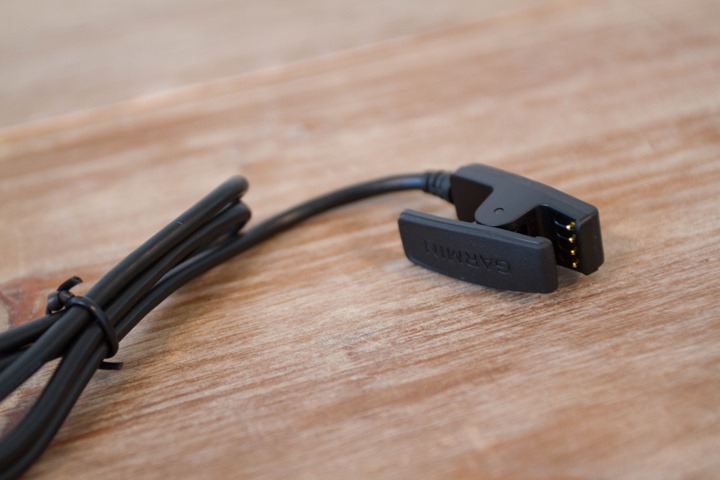
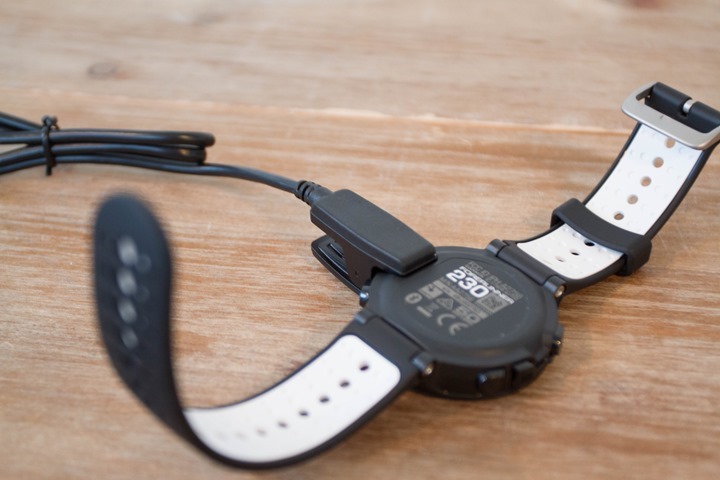
For the HR strap, note that it’s only included on the FR230 bundle including the heart rate strap. If you buy a FR235 you won’t get one (you’ll get an optical sensor). And if you buy just the base FR230 – again, no strap. In any case, here’s the strap (HRM4):
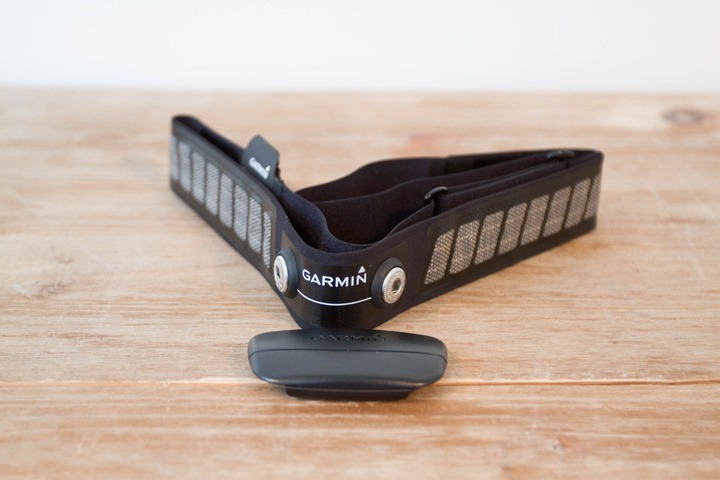
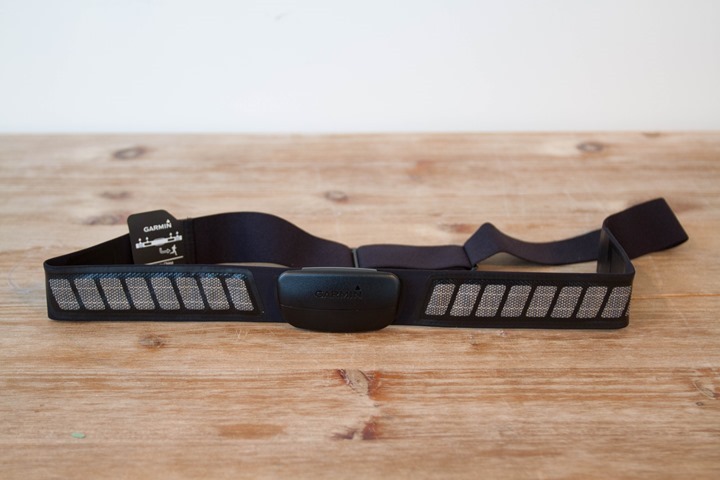
The above strap does NOT have Running Dynamics (that’s the HRM-RUN & HRM-TRI). It doesn’t matter though what strap you pair to the FR230/FR235, it won’t read Running Dynamics data from it.
Next we’ve got the unit itself, first the FR230:
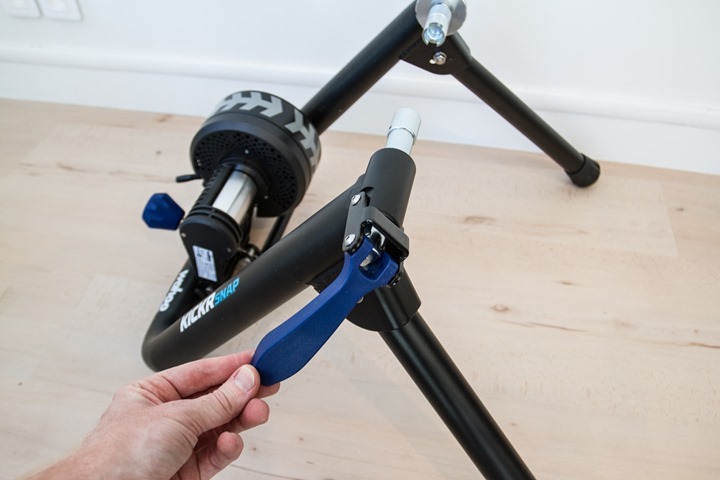
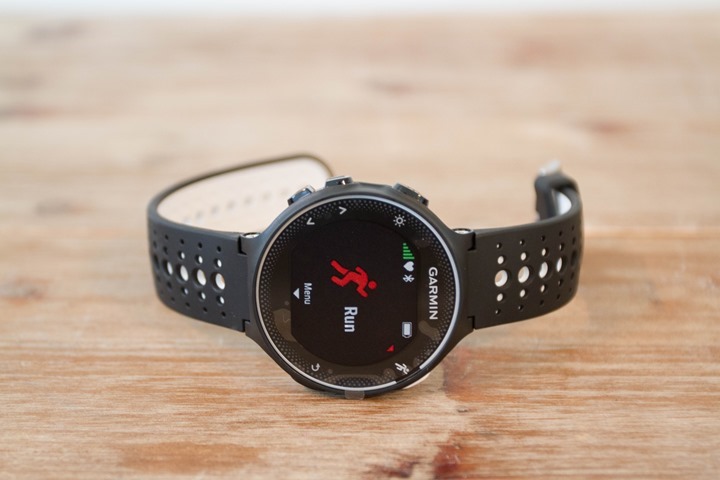
Then the FR235 with it. The easiest way to tell my two units apart is that the black FR230 has a white trim, whereas the black FR235 lacks such trim.
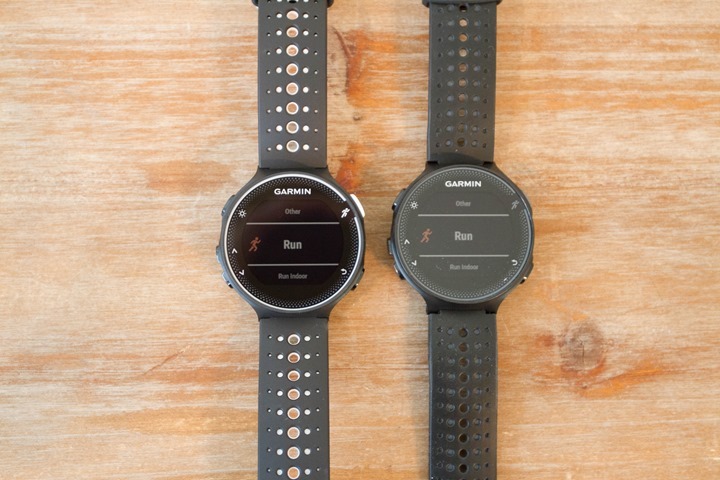
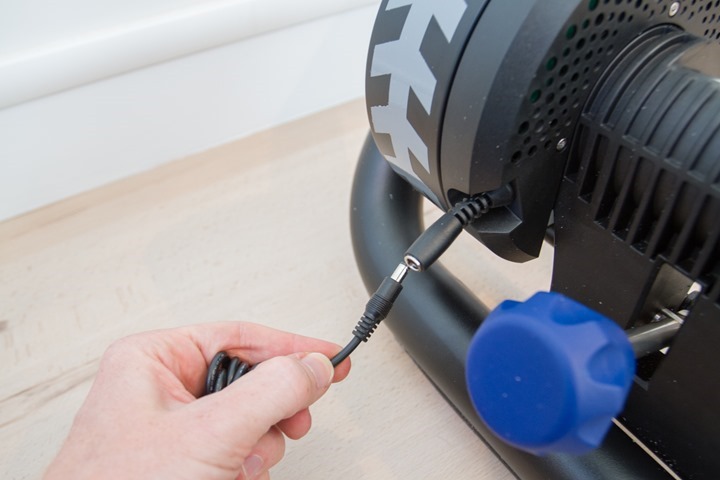
With everything unboxed, let’s compare sizes.
Weight & Size Comparisons:
Next, let’s take a look at the weight. The FR230 & FR235 are very similar in weight, only 1g apart! The FR230 weighs 41g, and the FR235 weighs 42g.
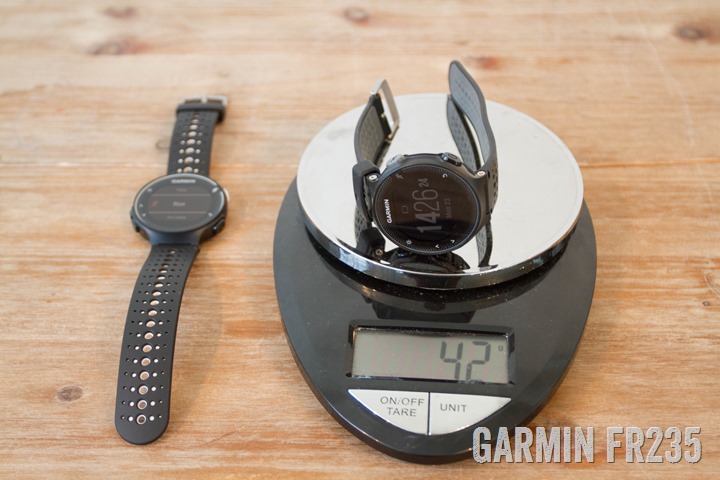
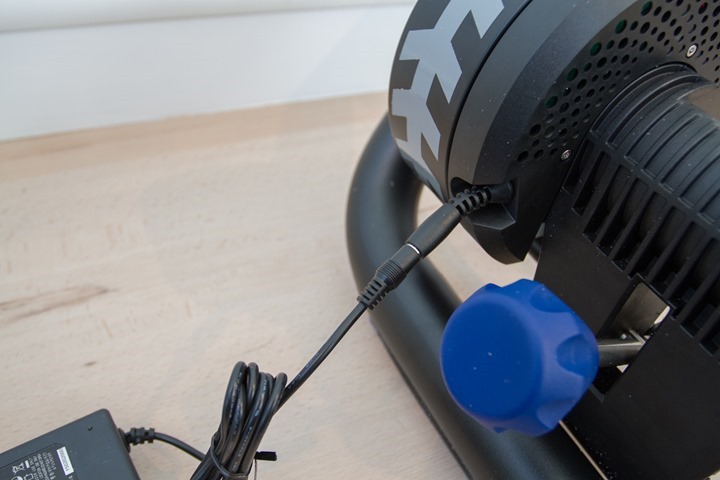
If you compare that to the TomTom Spark, it weighs in at 47g (depending on band):
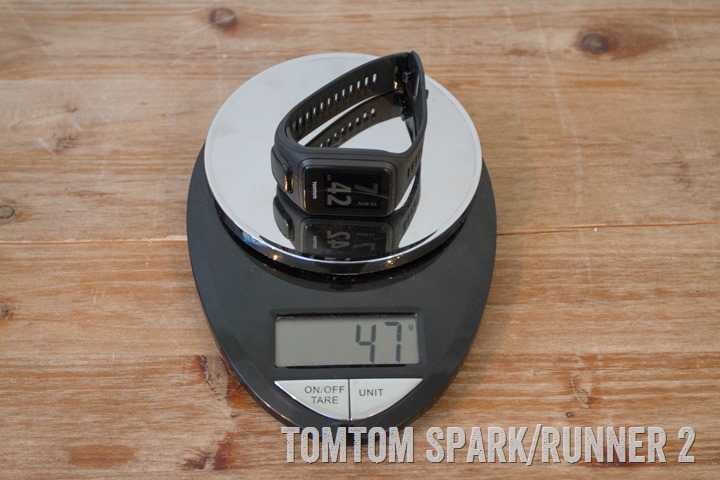
Next, here’s a side-profile view of many modern GPS running watches on the market. From left to right we’ve got:

From left to right: Garmin Epix, Garmin FR920XT, Suunto Traverse, Suunto Ambit3 Peak, Polar V800, Garmin FR225, Garmin FR630, Garmin FR235, TomTom Spark, Garmin FR25.
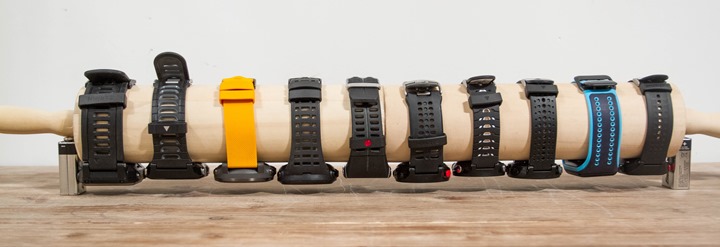
So basically, I’ve pretty much showed what we already knew – the FR235 is a super-slim GPS running watch that doesn’t weigh much.
Running:
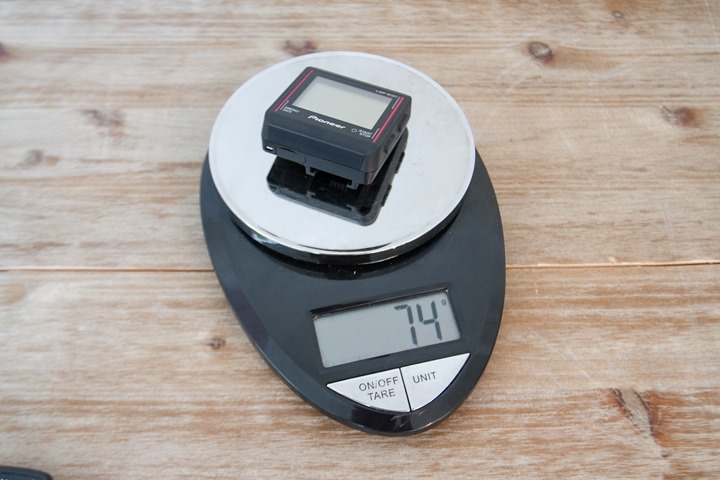
To start a run, you’ll press the power button once, which triggers a screen enabling you to select an activity profile (note though, in this most recent public beta, this behavior changes slightly to minimize one of these steps). It’s here that you’ll select to Run outdoors or indoors:
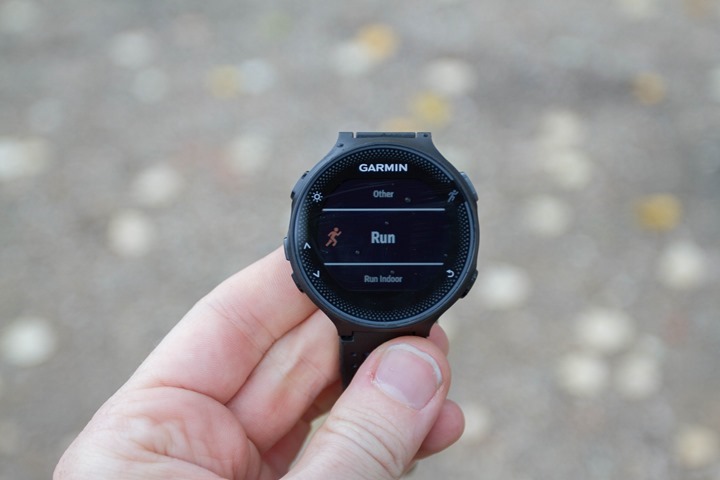
Note that on the FR230/235, you get four activity profiles: Run Indoors, Run Outdoors, Bike Outdoors, and ‘Other’. On the FR230/235 you cannot rename these profiles, or create new ones. On the FR630 however, you can create your own.
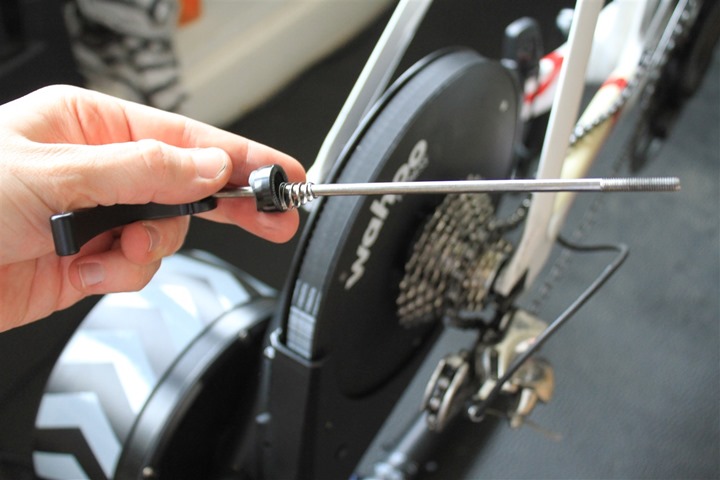
Once you’ve selected one, the unit goes off and finds satellite coverage. In most cases, if you’ve been in the same spot as previous and downloaded the satellite cache (happens automatically with the Garmin Connect and Garmin Express apps), this usually takes under 15 seconds.
Once that’s done, it’ll bring you to the main data page (you can still see satellite status up top until you start).
These data pages are totally customizable, with up to four data fields each.
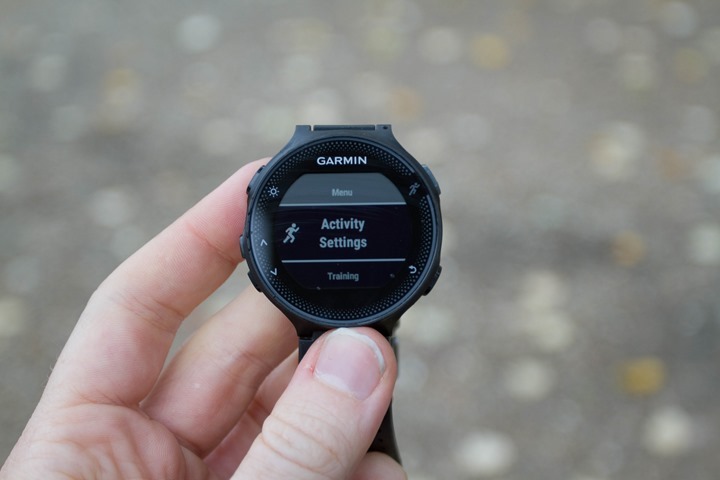
You get a bunch of pages, some tweakable, some not. Here’s the rundown:
Customizable Data Page 1 (1-4 fields)
Customizable Data Page 2 (1-4 fields)
Heart Rate Screen (Split: HR bpm & HR zone)
HR Zone Gauge (a little gauge of your HR)
Clock Page (current date/time)
Each of these can be enabled/disabled as you see fit. Here’s what they all look like:
As far as sensors goes, the FR230 & FR235 both support connecting to ANT+ heart rate sensors, ANT+ footpods, and ANT+ cycling speed/cadence sensors (more on the bike stuff later). For the FR235, you can choose whether to use the internal sensor, or an external HR sensor. Note however, that at present the footpod is really only useful for indoors, and not outdoors – since you can’t select to use it for pace outdoors.
With that all set, let’s start the run. At this point, the unit will show you current pace from GPS as well as distance and any other metrics you choose.
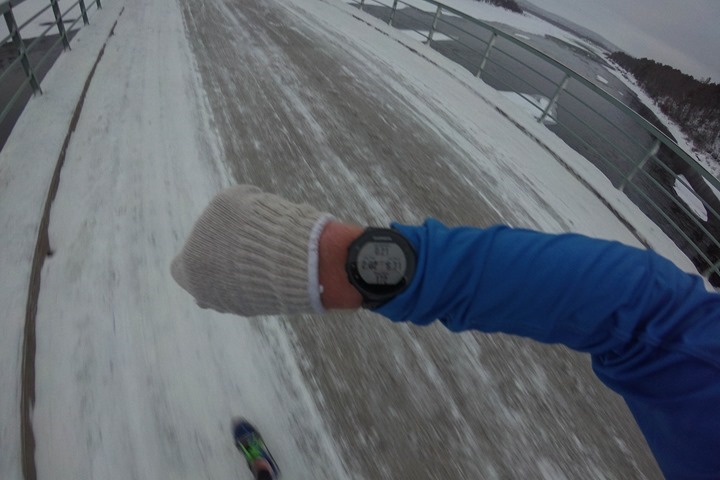
The unit includes basics like Auto Pause (which pauses the watch recording when you stop at a traffic light), Auto Lap (to automatically create laps at a distance of your choosing), and alerts. Standard alerts can be configured for Time, Pace, Distance, Calories, Heart Rate, or Run/Walk. Additionally, you can create custom alerts to remind you to Drink, Eat, Turn Around, or ‘Go Home’. These custom ones essentially work on a time/distance parameter – such as ‘every 10 minutes drink’, or ‘go home after 30 mins’.
In the event you want to do a custom workout, you’ve got a few options. One way is to create a workout on Garmin Connect (using a desktop computer), and then transfer it to the watch using either USB or your phone. In this case, you can create complex custom workouts like the below:

Additionally, you can also create an interval workout using a more simplified interval option on the unit itself. This allows you to program various steps in without too much complexity:
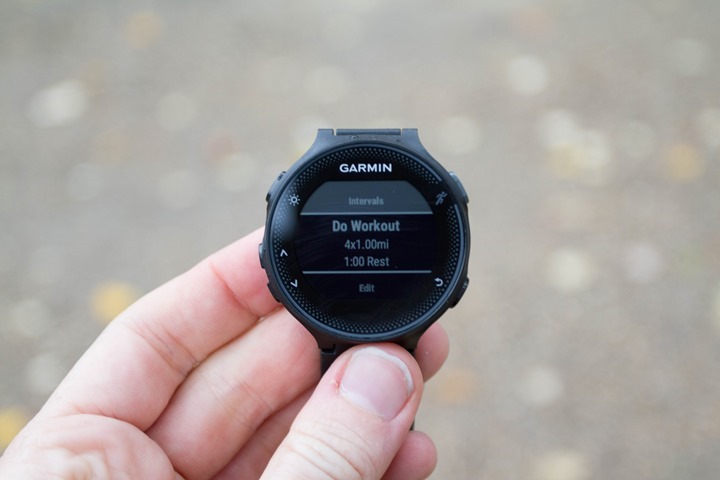
Now for the most part all of this stuff I’ve talked about to date is standard stuff for Garmin running units.
Where it starts to get interesting is new features like the ‘Finish Time’ estimator. This feature will automatically estimate how much time you have remaining until you hit a goal distance (such as 5K, 10K, etc…). You can enter a custom distance in as well as standard ones, using miles or kilometers. It’ll simply figure out what your estimated time of completion is based on how fast you’re running thus far.
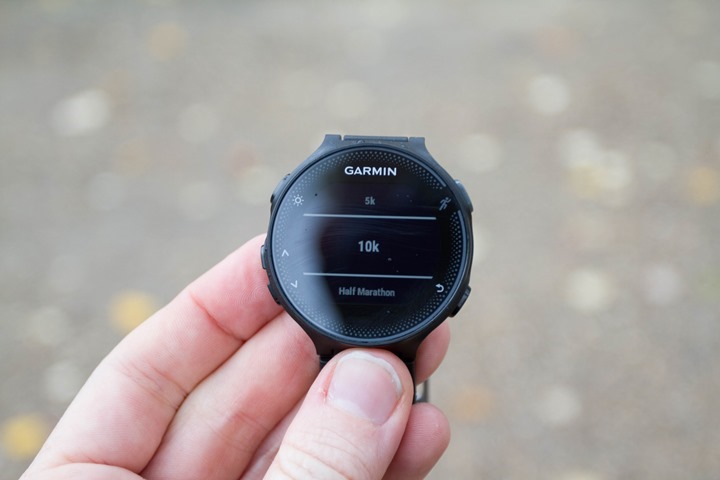
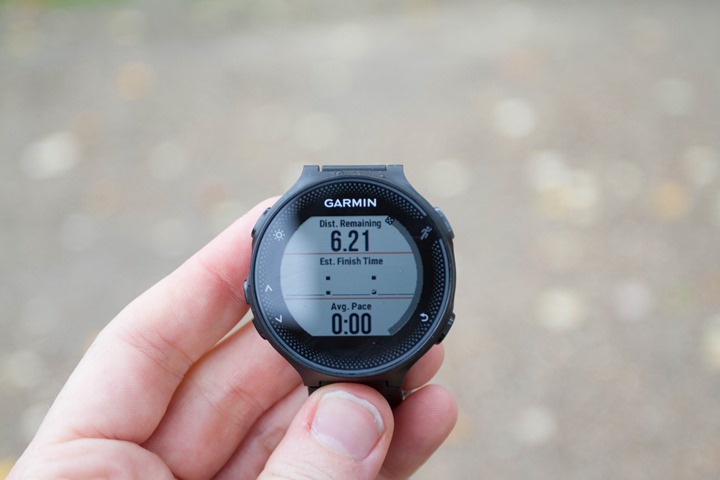
Next, we’ve got some post-run metrics. The FR230 & FR235 both support VO2Max, even using the optical sensor (a rarity in the industry). In this case, the unit will give you a VO2Max value after each run (if it changes). It’ll also plot this online. Right now the FR235 estimates my VO2Max at 55, which is a touch bit below where I’ve had it measured previously. However, at the same time, the FR630 is measuring it also at 55 right now. Note though that historically these features can take many weeks – specifically of harder runs – to even out on the watch as it learns from you.
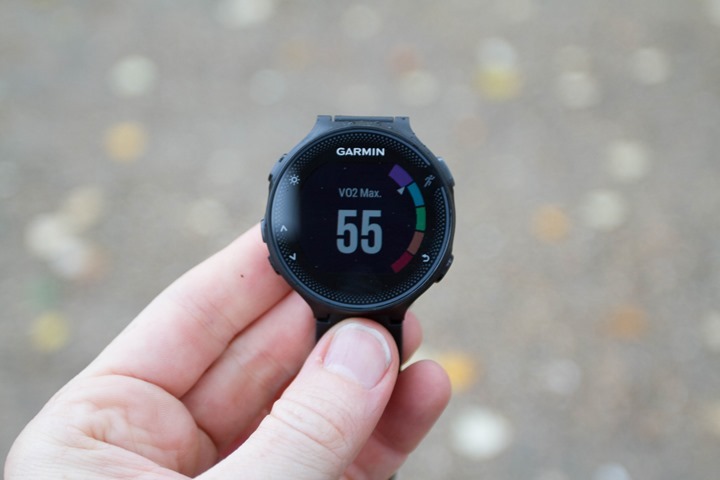
Similarly, I’ve been doing tests using a FR230 and FR630 with HR straps, while also using the FR235 with the optical sensor – looking at recovery time. IN most cases, they’re within an hour of each other (even if I think they’re a bit high overall).
Additionally, post-workout you’ll also get a TE (Training Effect) score too, if you look at the summary information:
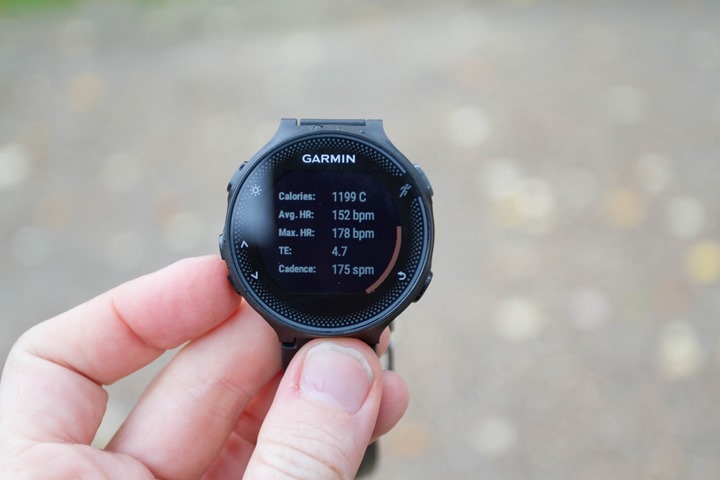
Again, this is also listed online too on the Garmin Connect page (different run below):

So what about GPS accuracy? So far so good. You’ve got two options when it comes to GPS, one is to use just the default GPS option, and the second is to enable GLONASS. Doing so would take a slight hit on battery (usually about 20%). For me, I’m OK with that. I’ve been doing a bunch of runs in/around the city (and in snowy weather), without seeing any real issues. For example, here’s going right along buildings without any GPS variance:

Here’s an example from actually earlier tonight where four GPS watches all slightly struggled through just one 100m section of the run – though the FR235 and Ambit3 tracked the least problematic until the turn, though then temporarily seemed offset for another 100m across the bridge before joining back up. To be fair, this is one of the hardest little sections of roadway I have around my home, since it’s a tiny road between two sets of tall buildings.

The rest of the run was largely spot-on between the units, or within a meter or two of each other.
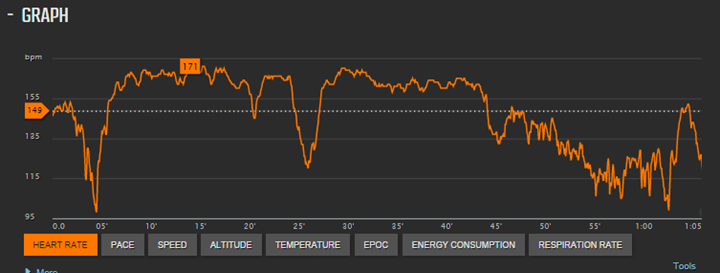

If you’d like to look at a few different GPS track comparisons, I’ve made a small table to allow you to dive into them below, using comparisons as well:
(Table to be uploaded Thursday Nov 27th, though files available now here)
Again, I’m not seeing anything that sticks out as concerning here (I’m also not doing a lot of trail running either right now, so if that’s more your thing you may need to wait and see what others say).
Finally, note one exciting feature on both the FR230 & FR235 is the ability to enable 1-second recording, as opposed to smart recording. That’ll help make your tracks look smoother (even if the distance under the hood is still theoretically the same). You can enable that in the settings menu.
Cycling:
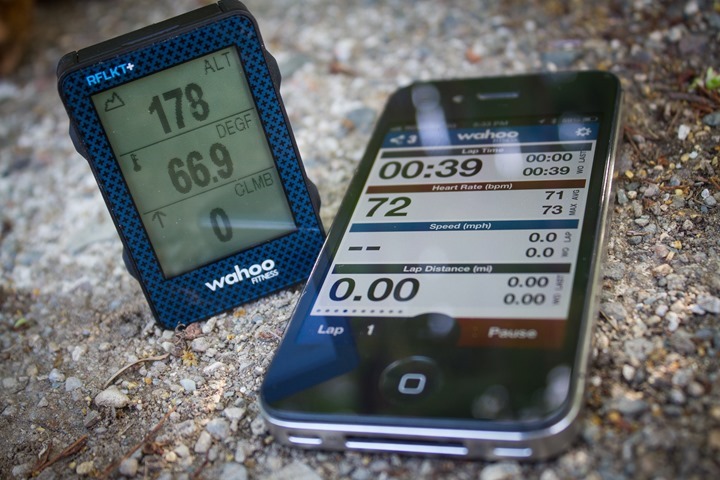
Next, the Garmin FR230 & FR235 has a cycling mode that supports ANT+ Speed/Cadence sensors. This means that you can pair it to any ANT+ Speed-only, Cadence-only, or Speed/Cadence combo sensor. It does not support Bluetooth Smart sensors (of any type).
I’m not going to spend a huge amount of time in this section because it’s primarily a running watch, not a cycling watch.
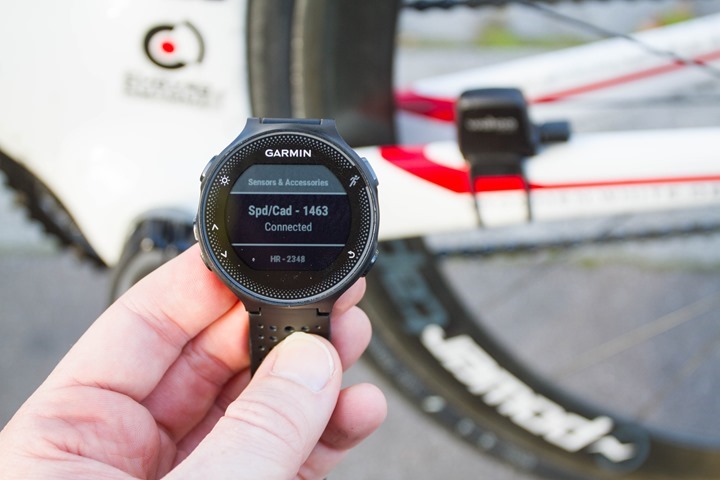
The main use for a cycling mode on the FR230/235 is simply that it categorizes your rides correctly for upload to Garmin Connect. This ensures things like PR’s (Personal Records) aren’t all dorked up on the running front, from cycling activities (such as fastest 5K times).
In my riding with the FR235, it works just fine as a record-keeper of where you rode. Both it and the multiple Edge units came up with near identical GPS results:
FR235: 25.61mi
Edge 520 #1: 25.66mi
Edge 520 #2: 25.63mi
Edge 520 #3: 25.68mi
Edge 810: 25.54mi
And afterwards, if you look on Garmin Connect, you’ll get speed/cadence data as you’d expect from any other Garmin device. This also includes speed, heart rate, distance and a map of where you went (here’s a link to one of my activities):

Note that for HR accuracy on the FR235 using the optical sensor, see my optical sensor accuracy section a bit a later in the post.
Finally, note that there’s a wee bit of confusion regarding whether or not there is or is not an Indoor Cycling mode on the FR230/235. I’ve discussed this in my ‘Bugs, Quirks & Tidbits’ section at the end of the review. If things change there – I’ll note that here as well. Failing changes there, you can always just turn off the GPS to use the unit indoors.
The FR235 Optical Sensor – Background & Rebroadcasting:
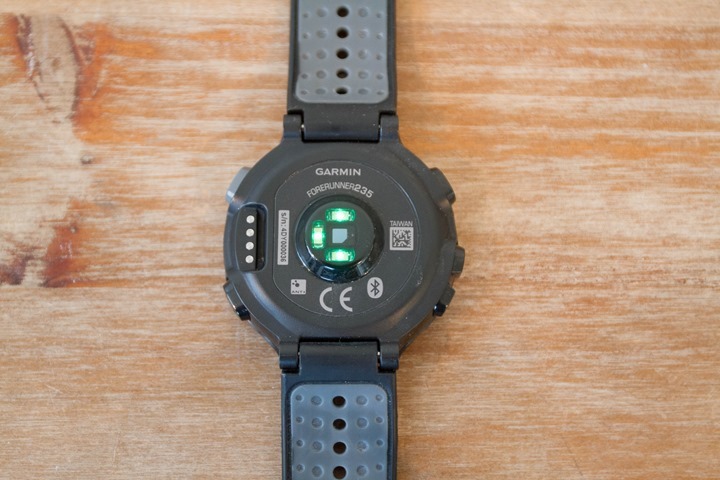
Without question the most important difference between the FR230 and FR235 is the optical heart rate sensor stuffed into the back of the FR235. This would mark Garmin’s 3rd product with an optical sensor, following the Forerunner 225 earlier this summer, and the Vivosmart HR (announced just a few days from the FR235).
In the case of the FR225, it leveraged an optical sensor package licensed from Mio. Whereas for the FR235 and Vivosmart HR, Garmin decided to make their own optical sensor, which they’ve branded ‘Elevate’. While the sensors between the FR235 and Vivosmart HR are similar, there are subtle differences to the surrounding units – making performance quite different.
Anytime a company introduces their own optical HR sensor, I shudder. Because the vast majority of companies screw it up, or don’t spend sufficient time testing. This is even more true in the athletic space (versus just resting HR sensors). Thus, it’s probably the most important thing I tested in the FR235, and where I spent the majority of my time digging into results.
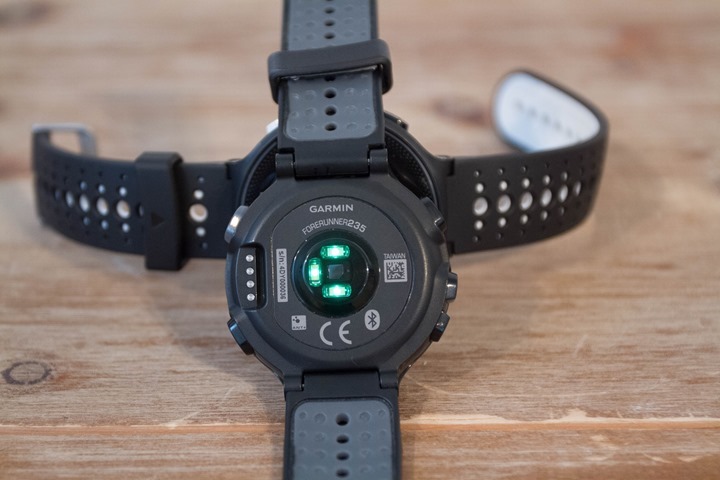
The sensor includes three green LED’s, which record not just workouts but 24×7 HR as well. In that mode, the unit samples at a variable rate dependent on what you’re doing. More activity means more HR data, while less activity means it reduces the HR sampling to save battery life. Meanwhile, in workout mode it records data at industry standard once per second (1s).
This HR is displayed just like it would be from a HR strap. Once you’re in an activity, there’s no difference there:

Further, outside of the workout mode as noted the unit is continually sampling your HR dependent on activity. But I dive into this more during the ‘Activity Tracker’ section a bit later.
Lastly, the FR235 can have its HR signal ‘rebroadcasted’ to other ANT+ capable devices. The unit rebroadcasts the HR over ANT+, identically to that of a heart rate strap. In effect, it turns your FR235 into a HR sensor for other devices – such as a Garmin Edge or a Recon Jet HUD unit. It does NOT broadcast your HR over Bluetooth Smart.
To enable this, you’ll start from the main time page and press down till you see this HR page:
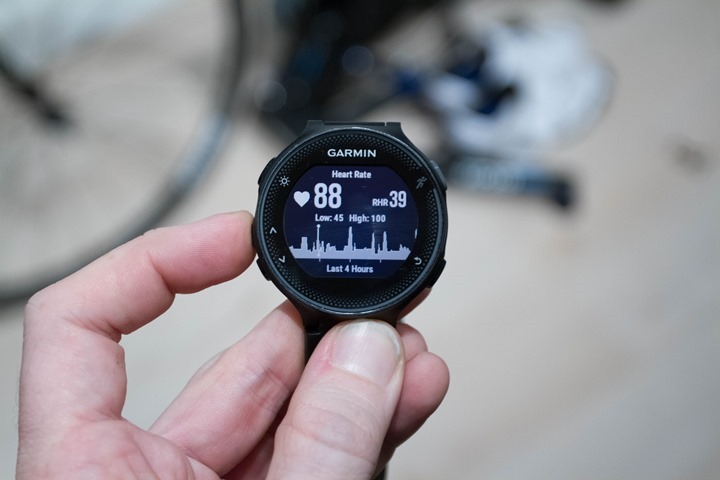
Then, you’ll HOLD the up button down for a few seconds, which gives you this little nugget:
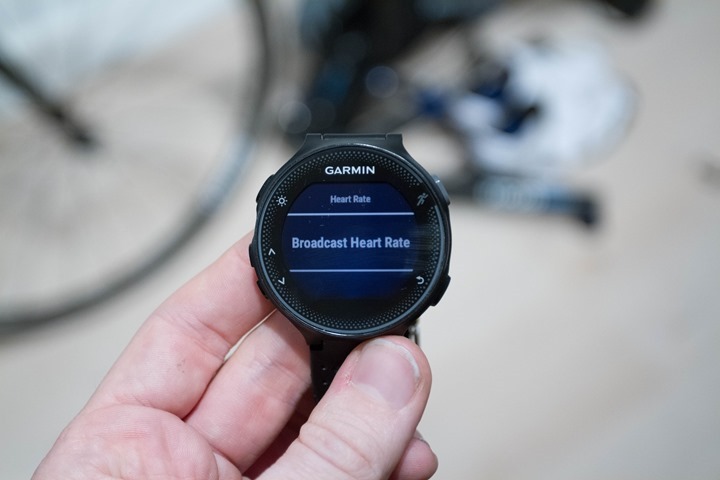
After selecting it, you’ll see your HR and time broadcast for all the world to pickup:
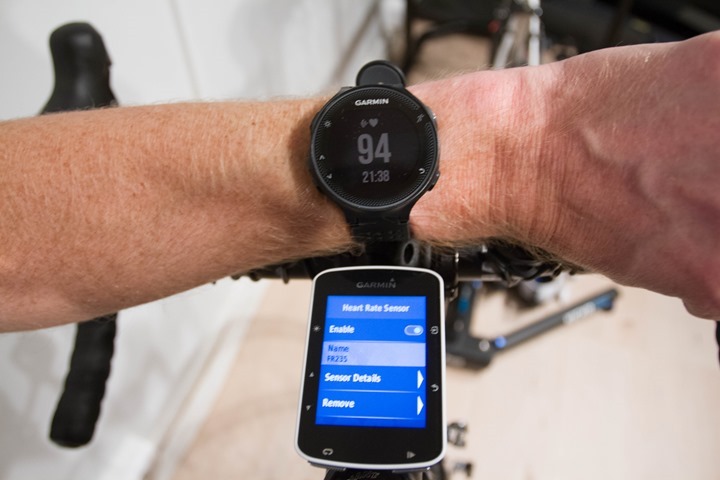
If you wander to another device – like an Edge series one, you can search for the HR signal and find it. And then boom – HR on the Edge, from the FR235:
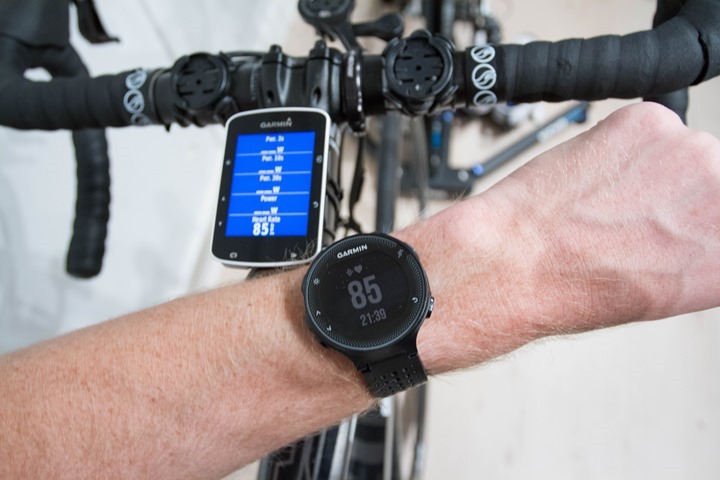
Note that in this mode you cannot start an activity. It’s only offered as a standalone option, which kinda makes sense. It’s sorta silly to record two activities of the same type to Garmin Connect. Though, I’m sure there’s edge cases that make sense too – such as the Recon Jet example where you want to record your bike ride on the FR235, while also getting HR up to the Recon Platform. Hopefully they’ll look at allowing/enabling a broadcast mode during a recorded workout as well.
As for signal strength, I haven’t seen any dropouts when using it on my wrist, paired to an Edge cycling computer on my bike (a relatively short distance). Additionally, in looking at signal strength as measured by a NPE WASP unit, things look on-par with a Garmin HRM4 Both were at the same distance from the WASP (which was on my handlebars), with one measuring –32db (HRM4) and one at –28db (FR235). The numbers are displayed negative, the closer to zero the better. Of course, even just moving an inch or two causes the numbers to fluctuate a bit – so don’t overthink the slight difference there – it’s just where the pic was taken.
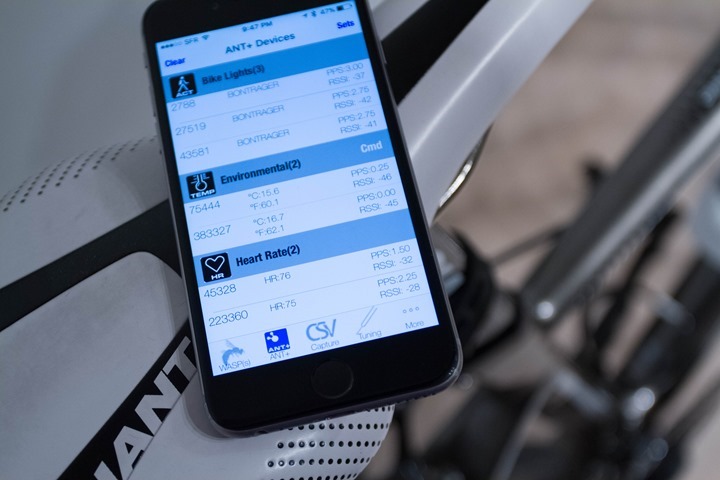
For fun, I then put the WASP module outside the room and half-way up the stairs, to see how well it’d pick up things. Sure enough, no problems with either displaying (now at –52 & –46):
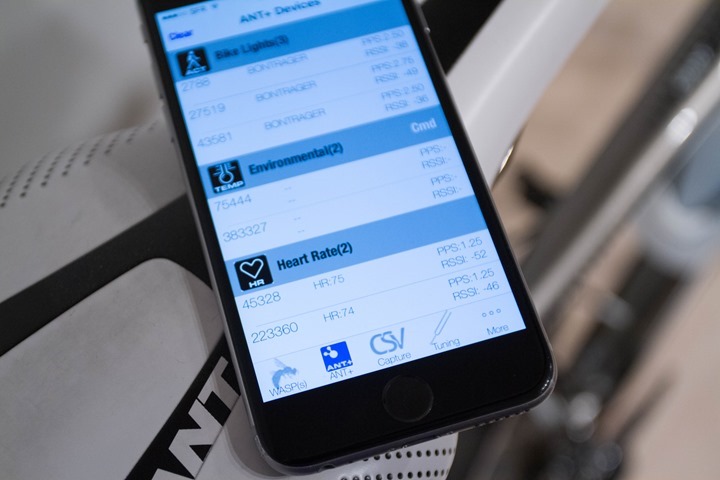
I haven’t done as much with re-broadcasting as just native recording though in my testing, so it’s possible there’s some edge case I haven’t hit yet. Still, things look positive there from a functionality perspective. Of course, whether or not the data is terribly useful (i.e. accurate) in cycling is a totally different matter.
The FR235 Optical Sensor – Workout Accuracy:
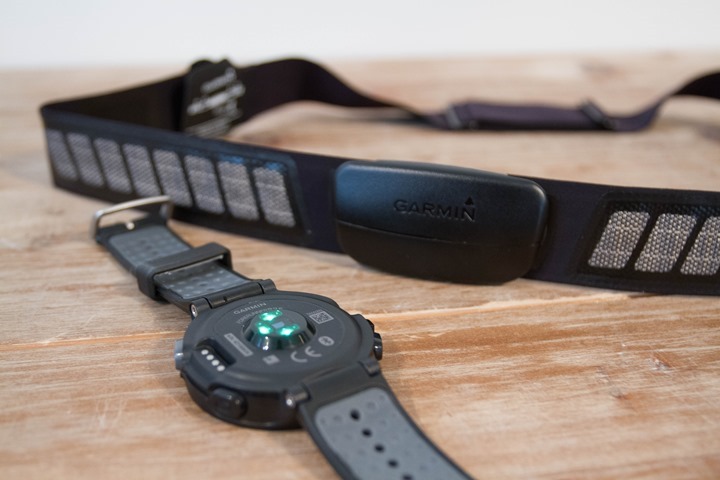
Now that we’ve got the optical sensor background pieces out of the way, let’s dive straight into accuracy testing. Because honestly, that’s all most of you care about anyway. For accuracy testing I’ve been using a production unit on production firmware for the past 2-3 weeks, with near-daily workouts of both cycling and running. I have not yet tried it swimming (since it’s not a swimming watch).
In my case, my testing setup is pretty straightforward, I’ve got the following on most activities:
A) Garmin FR235 (Optical HR Sensor) – Right Wrist
B) TomTom Spark or Polar A360 (Optical HR Sensors) – Left Wrist
C) Garmin HRM-TRI & HRM-RUNv2 HR Chest Straps (Upper chest)
D) Stryd Power & HR Chest Strap (Lower Chest)
E) Scosche Rhythm+ Optical HR Sensor (Upper right arm)
Note, in the above test I’m careful to not put two optical HR sensors on the same wrist area. This can impact accuracy adversely for some sensors – so I don’t want to impact results adversely that wouldn’t otherwise be normal.
For data collection, the three non-wrist-worn units were funneled to a variety of FR920XT, Suunto Ambit3, and FR630 units that I usually wore in a SPIBELT. These were purely there for HR data collection, and not GPS accuracy data. In the case of cycling, most of the data was instead funneled to Garmin Edge units for record-keeping. Finally, all of this data is available at the end of the post for your own poking.
Ok, enough talk – let’s walk through results. First up is a hill repeat session I did back a few weeks ago.
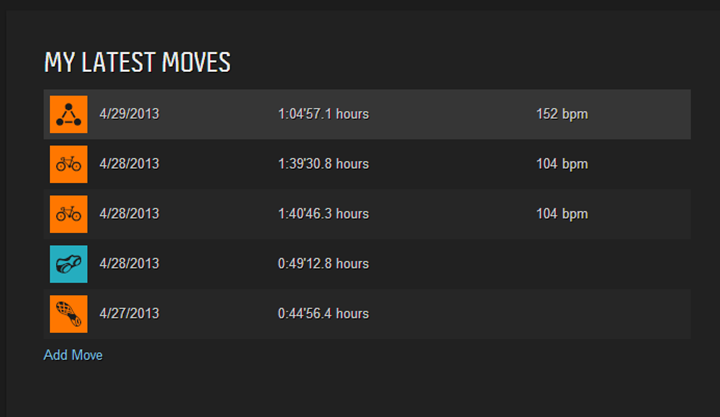
Below is the key for the above. Note, those are not averages, but just wherever my curser was at that time. What you see above is that things track very well for Mr. Purple (the FR235). The brief issue you see at the start with the Scosche is because the strap caught/pulled loose on my clothing and I had to fix it while running – so it was flapping around.

The only issue you see on the Garmin FR235 side is some delay on the HR recovery as I ran down a hill. You see a small hint of this again later in the run too. But otherwise, it’s pretty much locked on the other units.
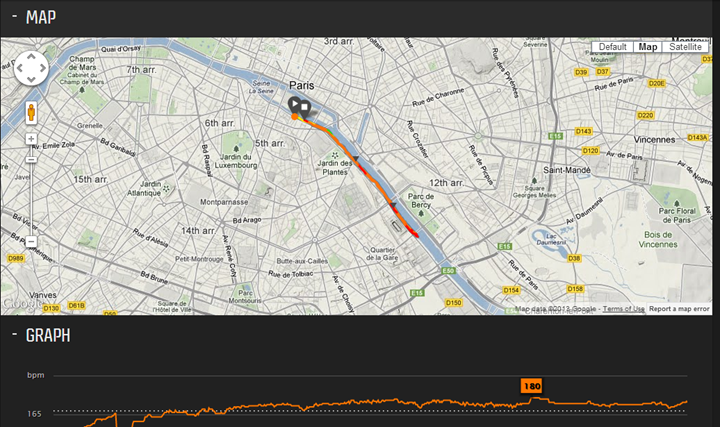
Next, let’s look at another hill repeat session I did – this one up in northern Finland in the snow. I’ll let you take this in for a second.

So yeah. Basically, what you see is that things are all good on the Garmin FR235 front until the recovery of each hill repeat (the part where I run downhill). So the FR235 nails the plot on the rise, but stumbles on the recovery. This particular hill was steep, and I was running in YakTraxs on ice, which meant that my stride rate actually increased a bit. What do we see then? The FR235 locks onto that instead of HR. In order to ‘reset’ it I basically stopped walking before starting my next repeat, which you see does the trick.
Now for fun, I then did a 10-minute sustained tempo portion after that. The unit tracks beautifully there – really nailing it.
So, to test my theory about the hill, the short hill from the main road down to our little snowy cabin was also equally steep. Sure enough, it did the exact same thing there when I ran the same way down it.

Now what’s interesting, is that in a later run down the same hill (you’ll see it two examples from now), I ran down the hill faster – so with a longer stride. That’s because I wasn’t in the recovery portion of an interval. When I had that longer/more natural stride – it had no problems. Just like it didn’t really have any major problems on my other hill repeats before in Paris.
Next, let’s look at a ‘simple’ run. This was basically just me wandering along at an easy Z2 pace, with a clean build. I finished with some short sprints. As you see here, the FR235 is kinda really ‘sharp’, as in, jagged.

Here, let me zoom in a bit to explain. See how generally smooth the red & green lines are? Then look at the teal FR235 line (or the TomTom Spark line) – they’re much more variable.

Still, despite that – it’s generally quite close most of the time – so for the above run, I’m content with the results, even if a tiny bit more variable (which they likely can easily address).
Next, let’s look at a run I did tonight. If I had to give this run a name, it’d basically be a “Let’s Hose It Up” test run. Essentially, optical sensors usually have issues with hard and fast pace changes. So after a short warm-up, I basically did some all-out chunks for 1-2 minutes. The average pace for these sections was about 5:35/mile (3:28/km).

During the warm-up, all four units tracked fairly well. However, what you see is the first and second intervals throw the Scosche for a loop, but also confused the Garmin FR235 too. The HRM4 and HRM-TRI had no problems tracking identically.
The third interval though the Scosche got the plot, but the FR235 struggled until about half-way through. Then finally, after that it got all happy and tracked the rest of the run quite nice. This could be simply because it took that long to get blood-flow up enough on a cooler evening for the optical sensors to catch-up. Yet, I didn’t tend to see such issues in the Arctic. The question is how often you do all-out intervals, and would it matter? As you’ll see in a moment, when I did those all-out sprint sections later in the run after more warm-up, it handled quite nicely.
Here’s my final Arctic run. In this case I basically warmed up nice and easy and kept it steady for about 30 minutes. Then I made for a hard run up a steep hill, before recovering briefly. From there, I did 30×30’s (30-seconds hard sprint, 30 seconds walk). A great way to test/look at recovery.
The guide for this in blue is actually both Scosche & FR235 (colors were auto-picked unfortunately), though thankfully it didn’t matter on this graph. The green is the Polar A360, and the red is the HRM-RUNv2 strap. Not that the colors matter, the FR235 nailed this easily. Not sure what the A360 was doing.
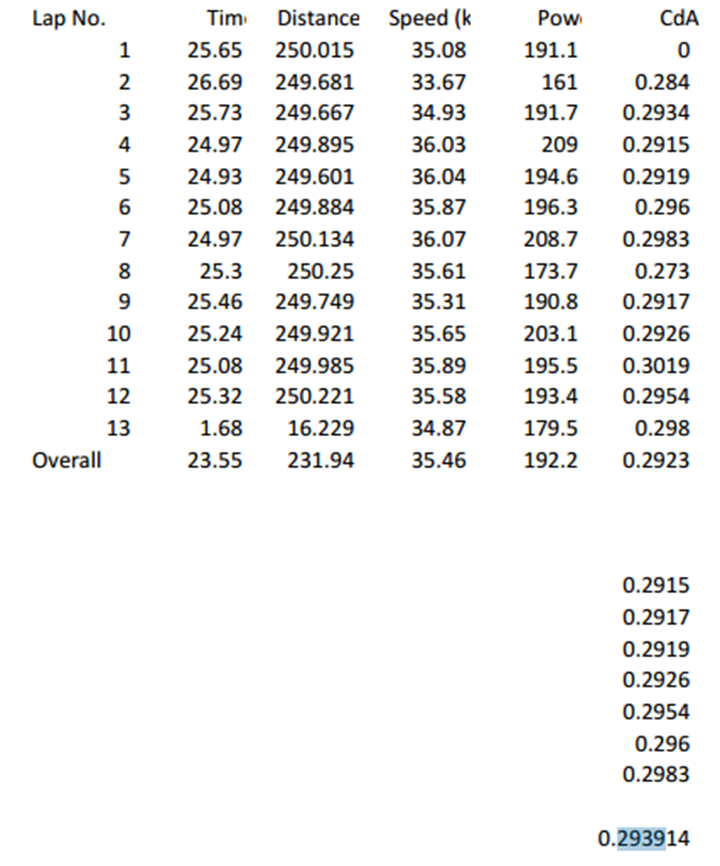
Here’s a closer look at the 30/30 portion. Again, green is the Polar A360, the others are the HRM-RUN HR strap, the Garmin FR235, and the Scosche Rhythm+ optical.
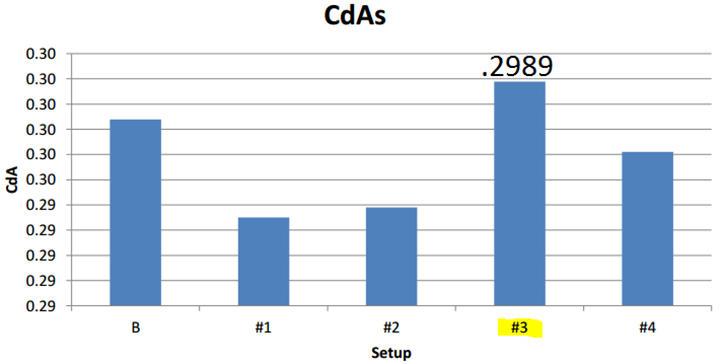
Very solid on that, despite the cold weather and the watch being partially exposed.
Next, on cycling. It’s outdoors that’s challenging for optical sensors on the wrist. This is because you’re ‘straining’ your wrist gripping the handlebars, and then any road vibrations nail the watch. And sure enough, it’s hard on the FR235 (sorta like I saw on the TomTom Spark sensor). It did better than the TomTom, but it’s super-jumpy. For example, in the below data plot I even added a 3s smoothing to it, just to make it easier to find the two lines given how jumpy it was. Here, compare before and after smoothing:
Before graph smoothing:
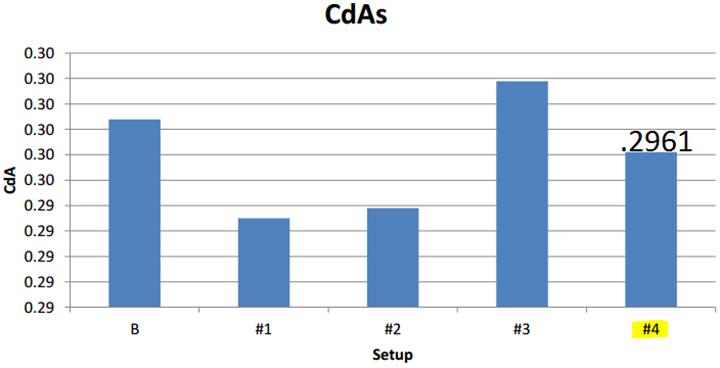
After smoothing:

What you notice is that while it gets the general concept if you’re looking at it from 50,000ft. But as you zoom in you realize there’s just a lot of cases where it doesn’t track quite as fast, or is much more variable, for example these sprints (this is showing some 12 minutes of time too!). That’s examples where things are dramatically different for 20-30 seconds at a time.
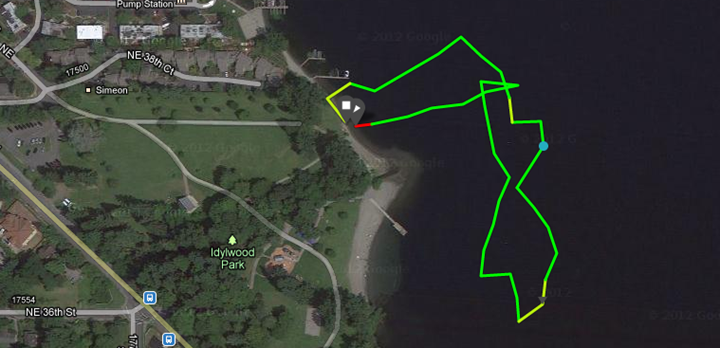
So where does that leave things overall? First off, keep in mind I usually use these sections to highlight ‘problem children’ sections, yet the vast majority of the run was otherwise fine.
So for the running side I’m giving it a very similar grade right now to that of the TomTom Spark: B+. There are cases where both units trip-up a bit. In most cases, those aren’t deal breakers, but I expect/hope that Garmin can tweak them over the coming months as they get more familiar with their own tech and the nuances. Some of the issues I had weren’t totally reproducible (for example, the downhill section on one of those hill repeats – but not other hill repeats). I probably wouldn’t use the FR235 as my primary HR sensor for cycling right now though – that’s just a bit too rough.
Activity Tracker:
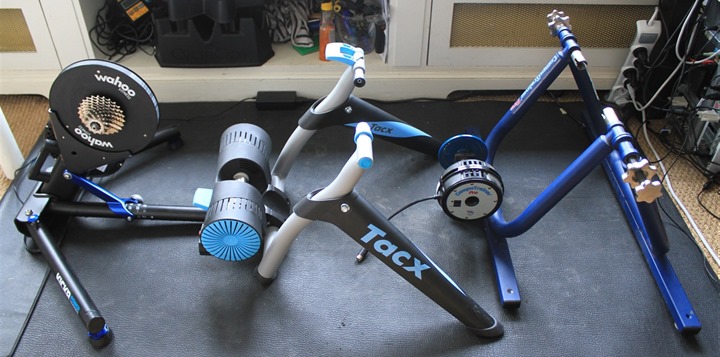
Like all recent Garmin wearables, the FR230/FR235 acts as an activity tracker as well. This means it’ll track your steps, calories, distance walked, and sleep. The functionality on the FR230/FR235 in these core areas is basically the same as other Garmin devices. So for example, you can tap down twice to get to the activity tracker widget page:
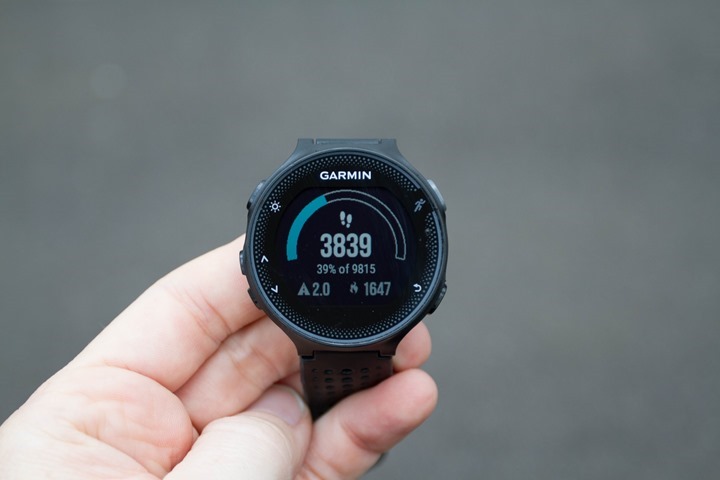
This shows your total steps for the day, progress towards a goal, as well as distance and calories.
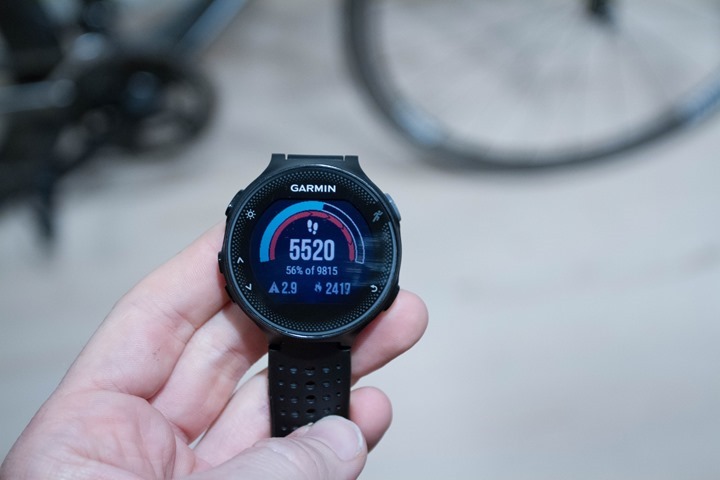
Additionally, see the red bar above? That’s the move bar – or basically the lazy bar. If that bar is filled up it means that you haven’t moved in an hour. Your goal in life is to keep that move bar from chirping at you at the end of the hour. You’ll do this by walking approximately 100m over the course of that time period. You can turn off the inactivity alerts if you’d like.
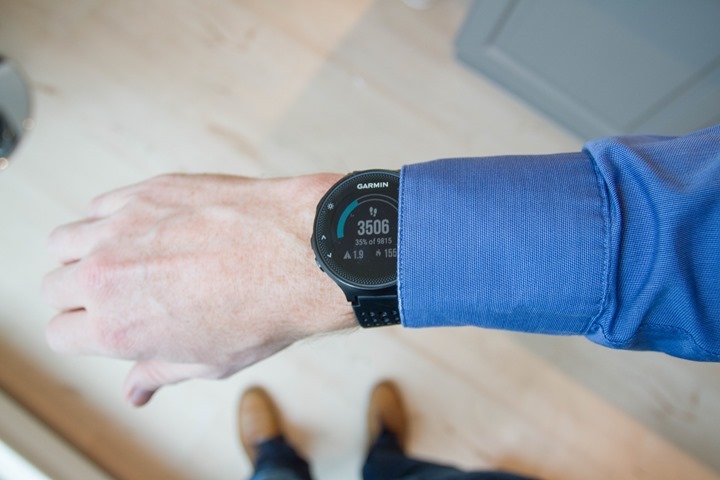
Next, you’ve got sleep metrics, which occur automatically with the FR230/235. You fall asleep, it records it. Garmin has made good strides over the past year in this area, adding much more depth than it did in the past. The only thing you’ll need to set (which happens automatically when you pair the watch to your phone) is the estimated sleep times. I just set mine randomly to 2AM-7AM, but from what I’ve seen it has no impact on the unit’s ability to estimate sleep. You don’t manually trigger it on the watch anymore. Instead, afterwards on Garmin Connect you’ll see sleep metrics:

Finally, on the FR235-only, you’ve got the ability to display and record 24×7 heart rate – more commonly called continuous HR. The main benefit of this (aside from geek factor) is to track resting HR.
You can access your instant/continuous HR anytime you’d like by just tapping the down button once, which shows this page:
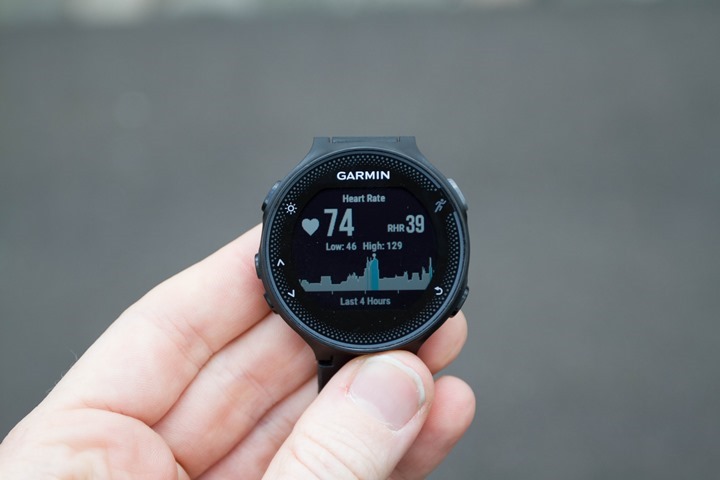
On the upper left you’ll see your current HR, while on the upper right you’ve got your resting HR for the day. Along the bottom is a graph for the last four hours, plus the high/lows during that time period.
The unit doesn’t sample or record this data at a straight rate of X times per minute/hour/etc, but rather does so variably, based on activity. You’ll notice that if you’re sitting still, it’ll sample far less often than if you’re up walking around. You can see this below where this morning I was sitting uninterrupted from roughly 8:45AM till 10:25AM (after riding cross-town round 8:25AM), so much so that there’s a few gaps in there where it didn’t sample at all. Yet as soon as I moved about – such as going for a short break/walk at 10:25AM, or my pedal home at 12:15PM, it shows more variability:
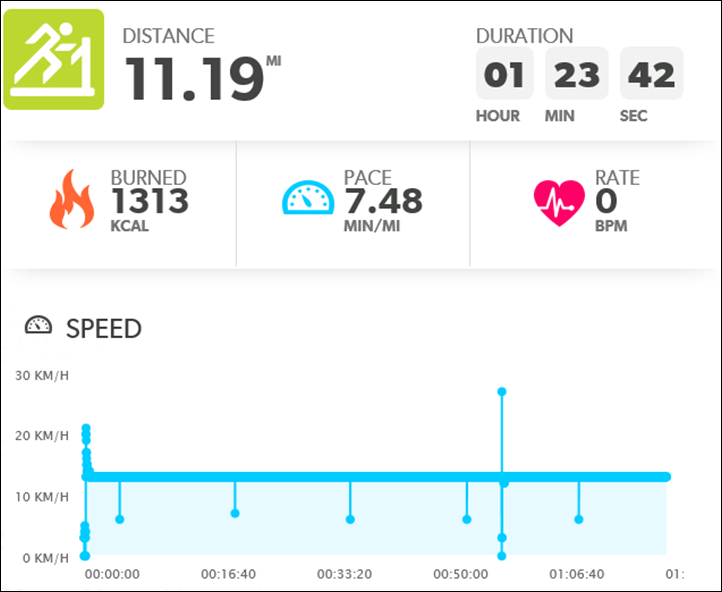
Back on the watch, you can also show your 7-day resting HR averages, which is (in my opinion) one of the best ways to see if you’re about to struggle in training.
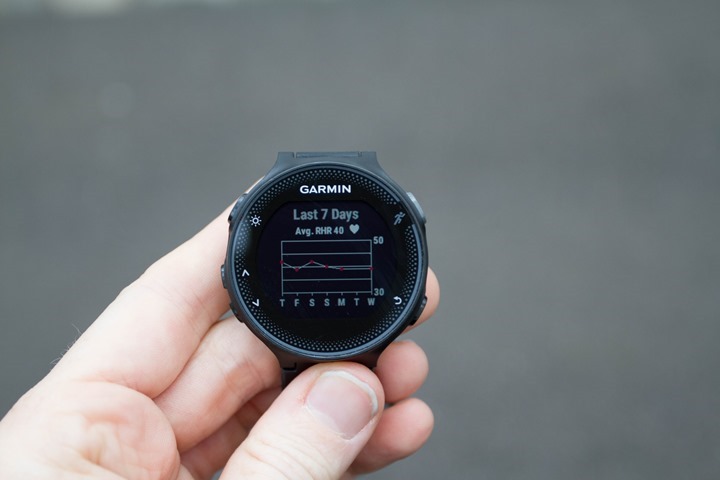
For example, I know my resting HR numbers well enough to know that if they rise above about 44-46bpm, I’m probably about to get sick – or having trouble recovering from travel. In the 50-52bpm range, I start to see my workouts diminish. Though oddly, some days appear to be missing from GC, despite showing up on the watch.

Of course, every person is different here. My resting HR is very low – 39-41BPM is the norm for me, and these numbers align quite nicely with what multiple other devices have shown for me in the past (including just simple HR straps for testing these values).
Again, the continuous HR options are only found on the FR235 and not on the FR230. You CANNOT pair another HR sensor to the FR230 to try and get the same features – no such pairing option exists. It’s only with the optical sensor.
Oh – one final interesting tidbit, you can indeed wear the watch while charging it at the same time, such as this:
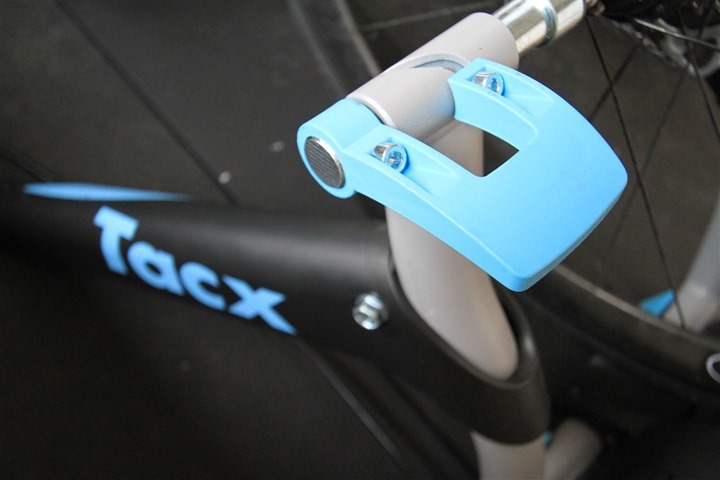
It might be a bit finicky to do this while running since the clamp design isn’t super-secure, but it would probably work if you were careful about how you arranged it. The unit DOES record during GPS activities while plugged into a USB battery pack. It does NOT record if plugged into a computer. Additionally, it does NOT record continuous HR while plugged in (likely because that lets in too much light).
Smartphone Notifications & Connect IQ Support:
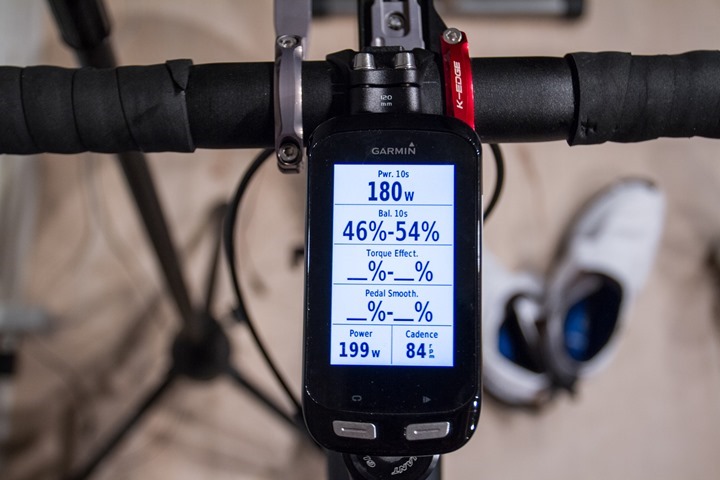
Like activity tracking, smartphone notifications and Connect IQ support is present on most Garmin wearables these days – and the FR230 & FR235 is no exception. In fact, this is probably one of the biggest changes from the FR220/FR225 – since it lacks these features.
To start, on smartphone notifications the unit uses the standard notification control panels from iOS and Android. So any notifications you setup on those devices are piped to the FR230/FR235. They’ll show up instantly on your watch, vibrating or beeping depending on what you’ve selected.
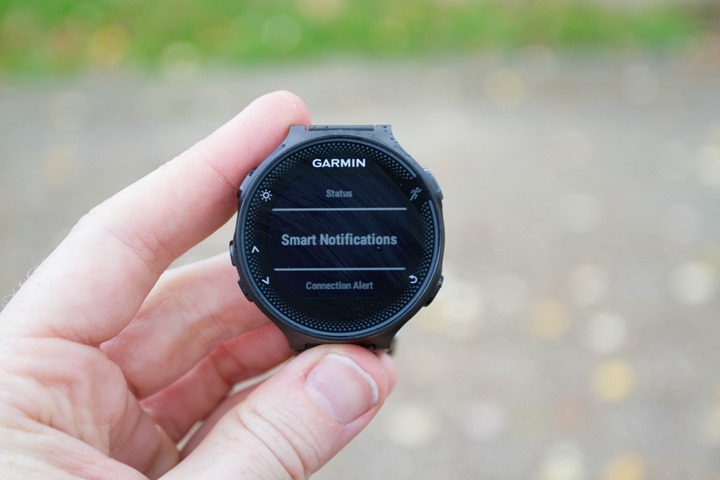
You can dismiss these notifications or open them up for more detail.
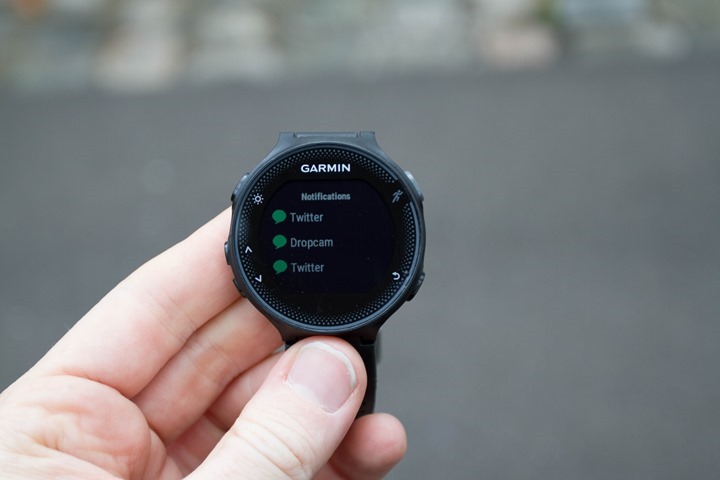
Further, you can access existing notifications through the widgets menu, in case you want to catch-up on previously displayed ones.
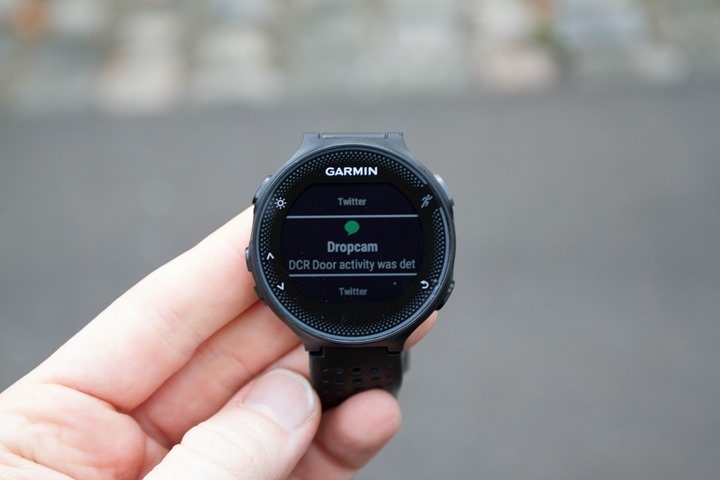
Notifications do NOT require the Garmin Connect app be open. However, for some other smartphone features like accessing your calendar, showing the weather, finding your phone, or syncing data, that does require the Garmin Connect app be open somewhere in the background of your phone. Here’s shots from all of those pages:
On the notifications front, I haven’t had any problems with the unit ‘forgetting’ my phone – it’s been working great the last few weeks for me. I’m not sure if that’s improvements in the Bluetooth stack on the iPhone, improvements from the Garmin side on the device, or just plain luck. But either way – I’m happy.
Next, we’ve got Connect IQ. This allows you to download various widgets, watch faces, data fields, and apps to your FR230/235. This in turn enables 3rd party developers to create things/apps for your watch that can extend/replace functionality of the device. I talk a ton more about that in these posts here.
In my testing, I tend to keep things fairly vanilla during the initial period (sans-Connect IQ), so in the event something goes wrong, I know it’s definitely a Garmin problem versus an app problem.
Backlight and Display:
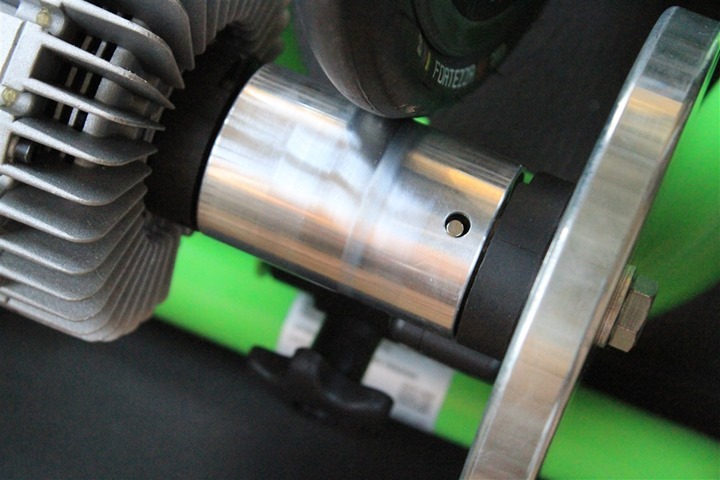
[New Section] There’s been a few questions and comments on the backlight and the display, both here after posting the review and on the Garmin Forums. So, I figured I’d take a few photos and give my thoughts.
First, remember that anytime you see photos of watch backlights – the exact luminosity of that display really comes down to the photographer. I can make any display look as bright or poor as I want merely by changing settings on the camera. That said, typically I just leave the settings largely on automatic. In this case, the only thing I tweaked after the fact in Lightroom was the white balance of the photo (in total) to get rid of the yellow glow. That’s it.
First, the photo you see above is all three watches (FR230, FR235, FR630), simply with their backlights enabled. On one of the units I put it at the pending/watch display screen. This means that it has white text on a black background. The other two are on usual mid-run screens with data fields.
Below is the same three watches, this time all lined up and all in running mode. From left to right they are: FR235, FR630, FR230
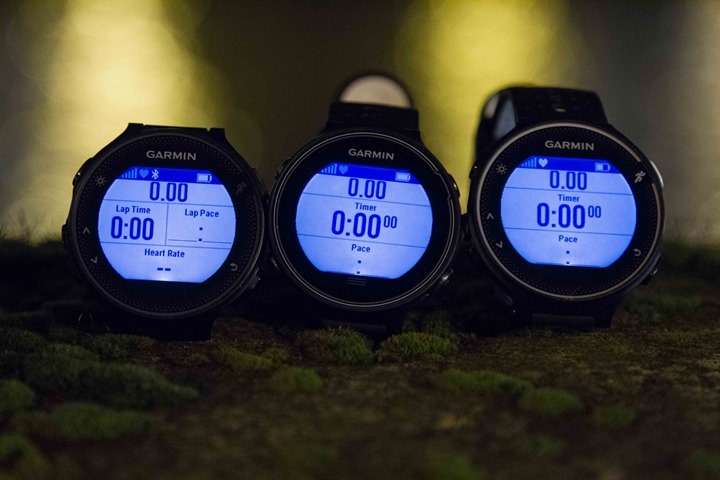
Note, I’ve seen some photos/videos of folks posting pictures of a backlight of various units during daylight – I’m not sure I totally understand the point there to be honest. Said differently: Try it in the dark, you know, where the light is for.
Finally, I zoomed back and took another photo, this time adding in a Garmin Fenix3 for comparison. As you can see, it’s brighter – so much so that it ‘blows out’ from a brightness standpoint. The rest of the photo is brighter than the others because there’s simply more light in the photo for the sensor to capture.
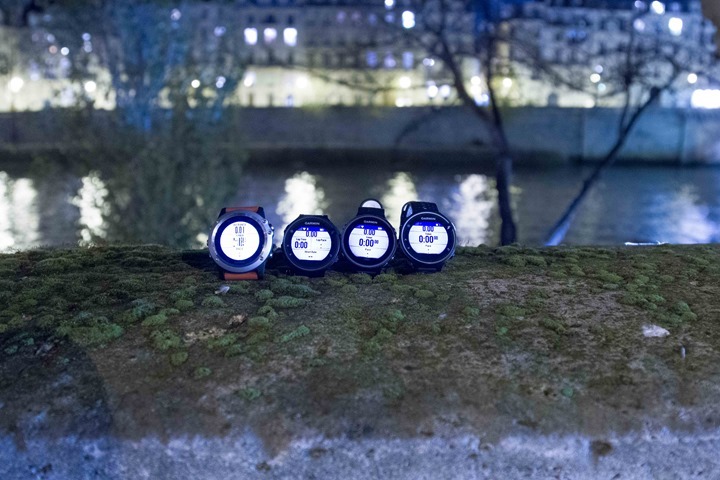
So is it bright enough to run with? Yes, absolutely. Approximately 80-90% of my runs with the unit were in the dark. It’s just that time of year for running.
Is it as bright as the Fenix3, or even the FR620? No. But it also doesn’t matter. It’s perfectly readable, and those watches are what I’d describe as ‘excessively bright’. Yes, it can be nice to have such a bright display if you’re trying to use it as a flashlight, but when I’m running, there’s no tangible benefit to that extra brightness. I can see the display just fine with the current brightness state. Some would even argue it makes it harder to see the text.
Of course, any brightness comparisons can be a personal thing and differ from person to person, but it’s not really something that bothers me on any of these units.
Bugs, Quirks, and Oddities
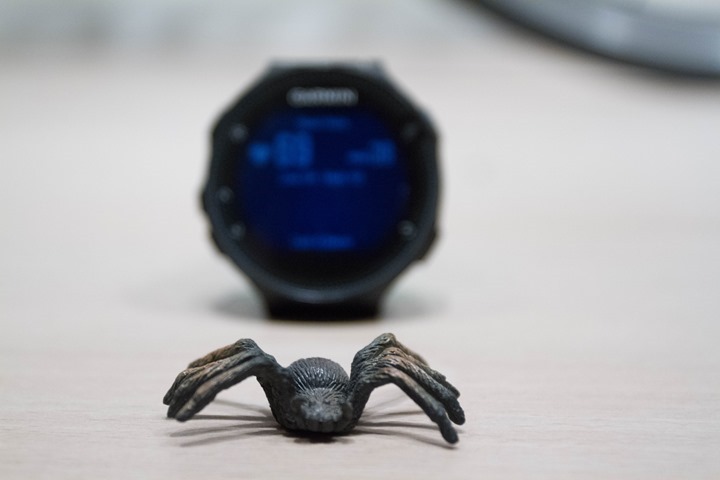
The FR230 & FR235 aren’t without their oddities. Most of these are fairly subtle, yet others are more concerning. Here’s a round-up of where things stand. If/when these get addressed, I’ll note it accordingly:
– FR235 Battery Life: It’s bad. Really bad. It’s about 2-2.5 days for me, using the optical HR sensor on its usual continuous mode (24×7). It’s supposed to be 9-11 days. Garmin says they’re aware of the issues and are working on it, with hopes to issue a firmware update in a few weeks. I’m sorta realistic though that something will have to give here – such as reduced sampling rates. Perhaps I’ll be proven wrong, but it’s a pretty big jump to increase battery life 4x over what’s there today without any negative impacts. Note: For some users, they are seeing more like 5-7 days.
– FR235 optical HR is a bit…jaggy: For lack of better term, perhaps spikey, the optical HR signal seems to be a bit non-smoothed. It’s rare that I ask for something to have more smoothing, but it seems like that might be called for here. I’m sure there are other ways they can address it, but it’s just a touch bit too variable. This isn’t a deal breaker right now, but is something they should address.
– FR235 optical HR quirks with fast pace shifts and some hill sections: As noted in the accuracy section.
– Currently within structured workouts (those that you create online and download to your watch), the unit fails to alert on pace based sections of a custom workout (high/low alerts). Fixed in firmware update on Feb 25th, 2016
– A few minor quirks, such as if you power off the unit temporarily (i.e. to reboot), it’ll actually fail to show the 4hr continuous HR graph upon powering back up (such as faintly seen in the background of the bug photo above).
Next, is the curious case of the indoor bike mode. This appears to be available on some people’s units, yet not other units. When I asked Garmin about this yesterday, they said it wasn’t a feature they planned on offering – yet it’s clearly on existing production units shipped to real customers. Oddly enough, my unit doesn’t have it as an activity profile I can enable (simply missing). I’ve re-checked in again today asking them to provide some clarification.
This mode was simply just like the outdoor cycling mode, but indoors. The only real purpose here is to automatically categorize the workouts on Garmin Connect as indoor cycling. You can otherwise replicate the same functionality by just turning off the GPS in cycling mode. Still, it has some benefit (and matches functionality seen on cheaper watches from TomTom and Polar).
Finally, we get to one particularly sore point – which is Garmin’s inability to get their specifications correct on their own website. Since announcement, the Garmin has listed Virtual Racer as a feature on the FR230/235. Yet, it’s not present. When I asked Garmin about this yesterday morning, they noted it was a mistake and would be removed shortly. As of this morning, it was still present.

Now, you may think this would be a minor mistake if not for the fact that it’s been there a month! Further, if this had been the first instance of it occurring, I’d be less concerned. But almost every product Garmin has released in the last year has had Garmin.com specifications errors that takes days to weeks to clean up. Quite honestly, this isn’t very hard. All they have to do is have a short meeting in a conference room with the web content folks and the product team folks and just scroll down the page and triple-check everything. It would take perhaps 10-15 mins to go through all 3-4 pages.
So yes, this is a clear ‘calling them out’ moment on repeated errors that are so easy to fix, yet significantly impact the consumer if they’re looking for that feature after purchase. In this case, Garmin says there are no plans to include the feature in the FR230/235.
Product Comparisons:
Like all products I’ve reviewed, you’ll find the FR230 & FR235 in the product comparison tool/database. This means you can mix and match features against other products I’ve reviewed or used. In the case of below, I’ve placed the FR225, FR230, FR235, and TomTom Spark all on the table for comparison. But you can easily mix and match your own comparison table right here.
Copyright DC Rainmaker – Updated February 16th, 2017 @ 10:33 amNew Window
Price$299$249$329$149-$199 (Features Vary)
Product Announcement DateMay 12th, 2015Oct 21st, 2015Oct 21st, 2015Sept 3rd, 2015
Actual Availability/Shipping DateJuly 2015November 2015November 2015October 1st, 2015
GPS Recording FunctionalityYesYesYesYes
Data TransferUSB, Bluetooth SmartUSB, Bluetooth SmartUSB, Bluetooth SmartUSB/Bluetooth Smart
Waterproofing50 Meters50 Meters50 Meters50m
Battery Life (GPS)7-10 hours16 hoursUp to 16 hoursUp to 11 hours (varies)
Recording IntervalSMART RECORDING (VARIABLE)1-second & Smart1-second & Smart1s
Satellite Pre-Loading via ComputerYes, 7 daysYesYes3 days
Quick Satellite ReceptionGreatGreatGreatYes
AlertsVIBRATE/SOUND/VISUALVIBRATE/SOUND/VISUALVIBRATE/SOUND/VISUALVIBRATE/SOUND/VISUAL
Backlight GreatnessGreatGoodGoodGreat
Ability to download custom apps to unit/deviceNoYesYesNo
Acts as daily activity monitor (steps, etc…)YesYesYesYes
Can control phone musicYesYesNo
Has music storage and playbackNoNoYes
Bluetooth Legacy (pre-4.0) to PhoneNoNoNoNo
Bluetooth Smart (4.0+) to Phone UploadingYesYesYesYes
Phone Notifications to unit (i.e. texts/calls/etc…)NoYesYesYes
Live Tracking (streaming location to website)YesYesYesNo
Group trackingNo
Emergency/SOS Message Notification (from watch to contacts)NoNoNoNo
Built-in cellular chip (no phone required)NoNoNoNo
Designed for cyclingBarely (Speed mode only)YesYesYes
Power Meter CapableNoWITH SOME CONNECT IQ APPS (BUT CANNOT RECORD DATA)WITH SOME CONNECT IQ APPS (BUT CANNOT RECORD DATA)No
Speed/Cadence Sensor CapableNoYesYesYes
Strava segments live on deviceNoNoNoNo
Crash detectionNo
Designed for runningYesYesYesYes
Footpod Capable (For treadmills)Yes (also has internal accelerometer)YES (Also has INTERNAL ACCELEROMETER)YES (Also has INTERNAL ACCELEROMETER)No (Can use internal accelerometer)
Running Dynamics (vertical oscillation, ground contact time, etc…)NoNoNoNo
VO2Max EstimationNoYesYesNo
Race PredictorNoYesYesNo
Recovery AdvisorNoYesYesNo
Run/Walk ModeYesYesYesNo
Designed for swimmingNo (protected though just fine)No (protected though just fine)No (protected though just fine)Yes
Openwater swimming modeN/AN/AN/ANo
Lap/Indoor Distance TrackingN/AN/AN/AYes
Record HR underwaterN/AN/AN/ANO (NOT ENABLED IN SWIM MODE)
Openwater Metrics (Stroke/etc.)N/AN/AN/ANo
Indoor Metrics (Stroke/etc.)N/AN/AN/AYes
Indoor Drill ModeN/AN/AN/ANo
Indoor auto-pause featureN/AN/AN/ANo
Change pool sizeN/AN/AN/AYes
Indoor Min/Max Pool LengthsN/AN/AN/A15m-50m
Ability to customize data fieldsN/AN/AN/AYes
Can change yards to metersN/AN/AN/AYes
Captures per length data – indoorsN/AN/AN/AYes
Indoor AlertsN/AN/AN/AGoals only
Designed for triathlonNoNoNoSorta
Multisport modeNoNoNoNo
Create/Follow custom workoutsYesYesYesNo
On-unit interval FeatureYesYesYesYes
Training Calendar FunctionalityYesYesYesNo
Auto Start/StopYesYesYesNo
Virtual Partner FeatureNoNoNoYes
Virtual Racer FeatureNoNoNoYes
Records PR’s – Personal Records (diff than history)YesYesYesNo
Day to day watch abilityYesYesYesYes
Hunting/Fishing/Ocean DataNoNoNoNo
Tidal Tables (Tide Information)NoNoNoNo
Jumpmaster mode (Parachuting)nONoNoNo
GeocachingnONoNonO
Weather Display (live data)NoYesYEsNo
Follow GPS Track (Courses/Waypoints)NoNoNoNo
Markers/Waypoint DirectionNoNoNoNo
Routable/Visual Maps (like car GPS)NoNoNoNo
Back to startNoYesYesNo
Impromptu Round Trip Route CreationNoNoNoNo
Download courses/routes from phone to unitNoNoNoNo
Altimeter TypeGPSGPSGPSGPS
Compass TypeN/AN/AN/ANone
Optical Heart Rate Sensor internallyYesNoYEsYes
Heart Rate Strap CompatibleYES (ALSO INTERNAL OPTICAL HR SENSOR)YesYesYes
ANT+ Heart Rate Strap CapableYesYesYesNo
ANT+ Speed/Cadence CapableNoYesYesNo
ANT+ Footpod CapableYesYesYesNo
ANT+ Power Meter CapableNoNoNoNo
ANT+ Weight Scale CapableNoNoNoNo
ANT+ Fitness Equipment (Gym)NoNoNONo
ANT+ Lighting ControlNoNoNONo
ANT+ Bike Radar IntegrationNoNoNONo
ANT+ Trainer Control (FE-C)NoNoNONo
ANT+ Remote ControlNoYES FOR GARMIN VIRBYES FOR GARMIN VIRBNo
ANT+ eBike CompatibilityNoNoNONo
ANT+ Muscle Oxygen (i.e. Moxy/BSX)YesNo
ANT+ Gear Shifting (i.e. SRAM ETAP)NoNo
Shimano Di2 ShiftingnONoNONo
Bluetooth Smart HR Strap CapableNoNoNOYes
Bluetooth Smart Speed/Cadence CapableNoNoNOYes
Bluetooth Smart Footpod CapableNoNoNONo, has internal accelerometer
Bluetooth Smart Power Meter CapableNoNoNONo
Temp Recording (internal sensor)NoNoNONo
Temp Recording (external sensor)NoYES (TEMPE)YES (TEMPE)No
Compatible with Firstbeat HR toolsNoTBDTBDNo
PC ApplicationGarmin ExpressGarmin ExpressGarmin ExpressMySports Connect
Web ApplicationGarmin ConnectGarmin ConnectGarmin ConnectTomTom MySports
Phone AppiOS/AndroidiOS/Android/Windows PhoneiOS/Android/Windows PhoneiOS/Android
Ability to Export SettingsNoNoNoNo
Amazon LinkLinkLinkLinkLink
Clever Training – Save a bunch with Clever Training VIP programLinkLinkLinkLink
Clever Training – Save a bunch with Clever Training VIP programLinkLinkLink
Review LinkLinkLinkLinkLink
Remember, you can mix and match your own comparison table here in the product comparison database.
Summary:
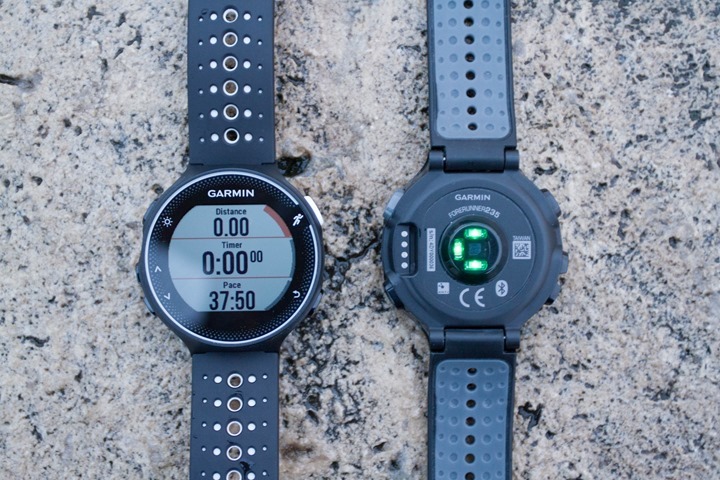
Overall I think the FR230 & FR235 may be the best bang for your buck running-specific watches that Garmin has released to date – even if there are still some minor kinks to work out on the optical HR pieces. If you look at the FR230 for example, it’s taking almost everything the FR620 had (except Running Dynamics) and porting it into a product slightly more than half the price of the higher end watches. And while Running Dynamics may be geeky-interesting, I don’t find them that interesting long term.
When it comes to the optical sensor on the FR235, from my testing it generally works quite well in normal runs, though there were a few edge cases where I managed to trick it briefly (such as the snowy hill descent, and the ‘Hose it up’ test run). Even when befuddled, it does seem to realize it, and snap back onto the right track. I suspect like most optical sensors it may be a bit of time before it’s 100% spot-on. Having seen the progression at various points over the past two months, I’m pretty optimistic about how much progress they’ve made on that front.
As for whether or not the FR235 will become my daily running watch? Hard to say, I think if they can work out some of the optical HR kinks, then it probably will. I don’t think I’d have any problems using it for long runs, and tempo runs – it worked well there. Even if they didn’t work out the kinks, then the FR230 would most definitely fit my bill. I tend to like lighter running watches over bigger ones (i.e. FR920XT/Fenix3), but that’s more a personal preference. And as nice as the FR630 may be, I’ve gotta say the buttons on the FR230/235 are just easier for me going into winter (than a touch screen).
With that – thanks for reading!
Found this review useful? Or just want a good deal? Here’s how:

Hopefully you found this review useful. At the end of the day, I’m an athlete just like you looking for the most detail possible on a new purchase – so my review is written from the standpoint of how I used the device. The reviews generally take a lot of hours to put together, so it’s a fair bit of work (and labor of love). As you probably noticed by looking below, I also take time to answer all the questions posted in the comments – and there’s quite a bit of detail in there as well.
I’ve partnered with Clever Training to offer all DC Rainmaker readers exclusive benefits on all products purchased. By joining the Clever Training VIP Program, you will earn 10% points on this item and 10% off (instantly) on thousands of other fitness products and accessories. Points can be used on your very next purchase at Clever Training for anything site-wide. You can read more about the details here. By joining, you not only support the site (and all the work I do here) – but you also get to enjoy the significant partnership benefits that are just for DC Rainmaker readers. And, since this item is more than $75, you get free 3-day (or less) US shipping as well.
Garmin Forerunner 230 (select drop-down for colors/bundles)
Garmin Forerunner 235 (select drop-down for colors)
Additionally, you can also use Amazon to purchase the units (though, no discount). Or, anything else you pickup on Amazon helps support the site as well (socks, laundry detergent, cowbells). If you’re outside the US, I’ve got links to all of the major individual country Amazon stores on the sidebar towards the top.
Thanks for reading! And as always, feel free to post comments or questions in the comments section below, I’ll be happy to try and answer them as quickly as possible.
